
DERMAL FILLERS
PEGylated hyaluronic acid
SAFETY IN AESTHETICS
Discover our new initiative CPD
Treating skin of colour

INNOVATIONS
Skin markers

clinical studies



DERMAL FILLERS
PEGylated hyaluronic acid
SAFETY IN AESTHETICS
Discover our new initiative CPD
Treating skin of colour

Skin markers

clinical studies

no lasers no needles, no risks.
VERSATILE APPLICATIONS
Scarring
Stretch marks
Active acne
Fine lines
Rosacea
Pigmentation
Melasma
Blepharoplasty
Dry Eyes
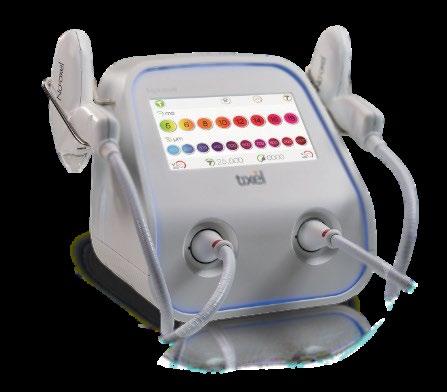
Unique patented TMA® technology
Scientifically validated Proven results
Trusted by clinics Loved by patients
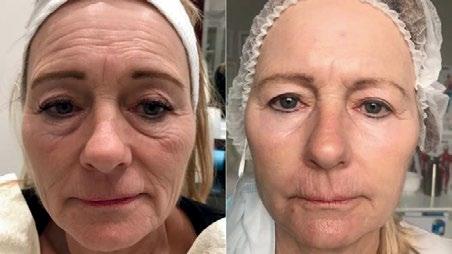



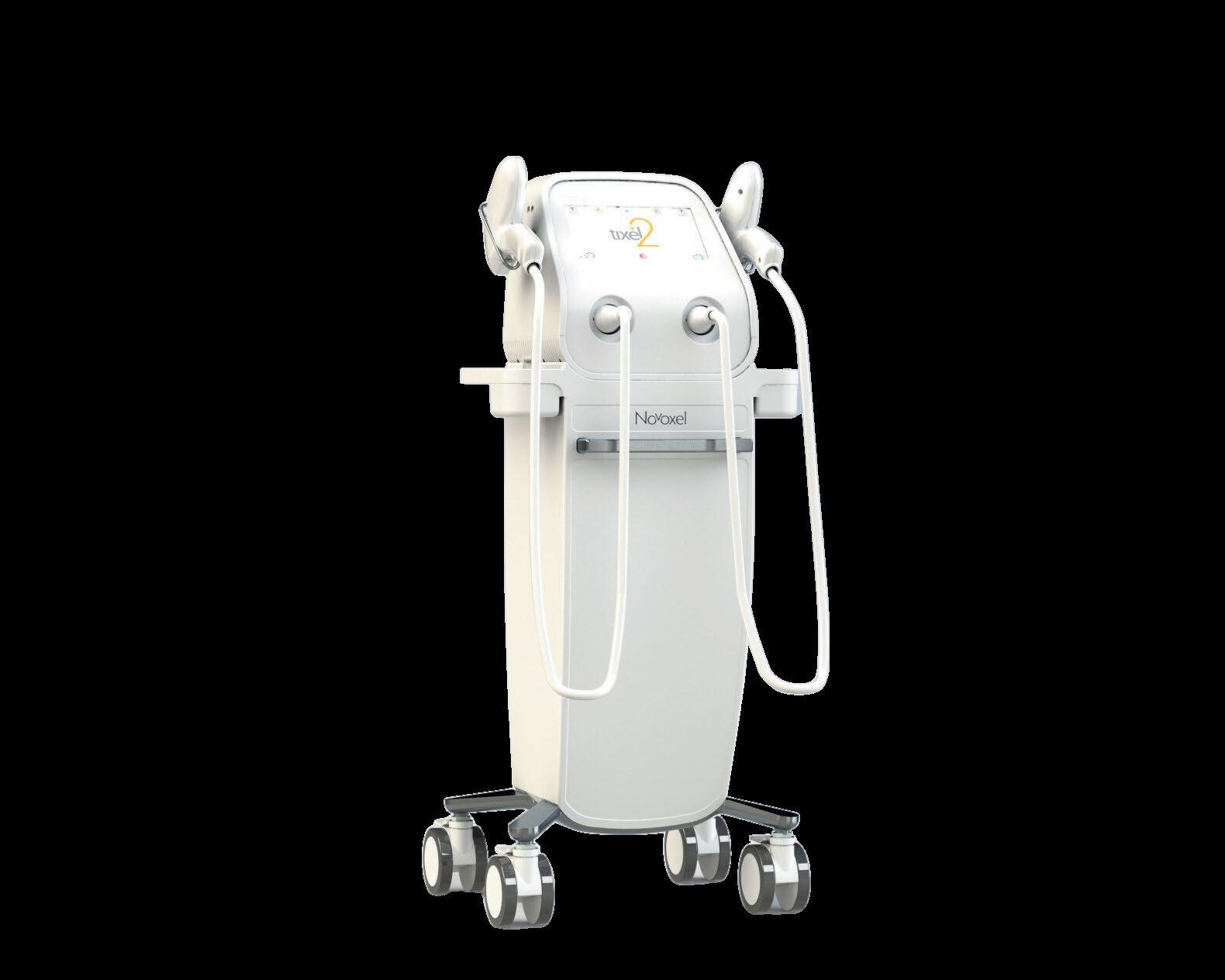




Welcome to the first issue of The Consulting Room Magazine for 2025.
In this issue, the focus is on safety and for good reason. The Consulting Room has joined forces with the Joint Council for Cosmetic Practitioners (JCCP) to launch a new initiative – Safety in Aesthetics.
The aim is to provide the public with all the information they need to make safe and informed decisions when choosing an aesthetic practitioner. Every clinic listed on the site is accredited, professionally trained, and properly insured, ensuring they prioritise patient well-
Also, on the topic of safety, leading UK consultant surgeon Gerard Lambe asks how much is too much when it comes to aesthetic treatments (p6); Piroska Cavell explores the delicate balance between ageism and aesthetics in the light of movies like The Substance and The Last Showgirl (p30-31) and we explore the topic of remote prescribing (p24-25).
As well as this, our CPD article for this month focuses on treating skin of colour (p60-63), and we find out how a new and innovative skin marker is enhancing safety (p53-55). We also have all the latest news (p6-10), and you can find out what events the team has attended
https://www.consultingroom.com/safety-in-aesthetics/find-out-more/ to find out more about Safety in Aesthetics and how you can get



The aesthetics industry has evolved significantly in recent years, embracing inclusivity and acknowledging the unique needs of individuals with different skin tones. However, despite some advances, aesthetic medicine training and clinical trials have remained largely centred around Caucasian skin, leaving significant gaps in knowledge and clinical training when it comes to treating patients with skin of colour.

How LPG® endermologie® mechanical stimulation technology can boost vitality, reduce stress, and enhance sleep.
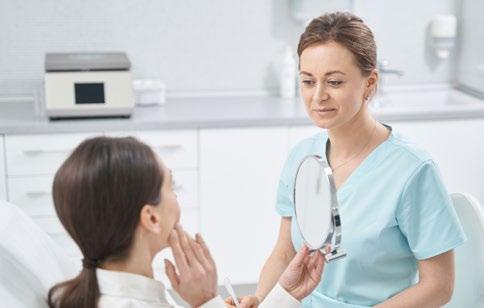
Why consultations are so important when it comes to safety in aesthetics.

The JCCP comments on the NMC’s recent determinations at a Fitness to Practice case relating to remote prescribing and delegation.


Sick of spending huge amounts of money on marketing and not seeing the results? The team from PatientPerfect explain what many clinics are missing.


Eddie Hooker, founder and CEO of Hamilton Fraser on how to safeguard yourself when adding menopause services to your aesthetics clinic.
The UK’s largest and longest running aesthetic industry information website and business portal. Consultingroom.com Ltd
E: admin@consultingroom.com
© Copyright 2018-2022 Consulting Room
Material may not be republished or reproduced in any form which removes attribution to Consulting Room, without the publisher's written permission. Press clippings can be obtained from the Editor. The publishers accept no responsibility for the information transmitted by contributors or advertisers through publication in the Consulting Room magazine. Inclusion of advertisements does not imply endorsement of the products or services advertised. The Editor's decision is final in all matters.
Published by Consultingroom.com Ltd, registered as a limited company in England; No. 4617405.

Advertising & Memberships
Dan Huxley | Sales Manager
E: admin@consultingroom.com
T: 01244 346 569
Marketing & Supplier Relations
Danielle Lowe | Marketing Manager
E: danielle@consultingroom.co.uk
Customer Support & Subscriptions
Membership Support Team
E: admin@consultingroom.com
E: craig@consultingroom.co.uk
Recruitment
Sabrina Haynes | Recruitment Specialist
E: sabrina@consultingroom.co.uk
T: 07734 203 105
Editor
Content Manager
E: editor@consultingroom.co.uk


Consulting Room has a long history of working with key figures within the global medical aesthetic community, many of whom are advisers on our website. We are honoured to welcome many of them, and others, to the Editorial Board of our quarterly magazine Without their wealth of knowledge and expertise in this diverse sector, we would not be able to provide the levels of educational content on clinical, nutritional and business topics that you will find within this magazine.
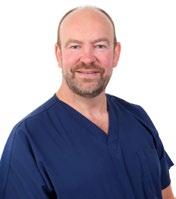
Dr David Eccleston 20 years in Medical Aesthetics and a Private GP. Clinical Director at MediZen. Local Country Ambassador for Allergan and lead investigator in many clinical trials.

Ron Myers Business Coach, Director of Aesthetic Business Partners LLP, former Director of HydraFacial UK and Co-Founder of The Consulting Room Group.

Prof Mark Whiteley Consultant Venous Surgeon & Founder of The Whiteley Clinic. Internationally recognised expert in venous disease and endovenous surgery.


Dr Patrick Treacy Founded the Ailesbury Clinic based in Dublin. Named Top Aesthetic Practitioner in the World (2019) and Top Aesthetic Medical Aesthetic Practitioner (Irl) 2023.

Martyn Roe A Specialist Business Consultant and Co-Founder of The Consulting Room Group. Martyn is the co-founder of Aesthetic Medical Partnership (AMP).

Madi Myers Biological Science graduate with a Masters (ANutr) in Human Nutrition from University of Aberdeen; an Association for Nutrition accredited course.

Dr Uliana Gout Educator & Speaker. British College of Aesthetic Medicine Former President & Int. Peeling Society Board. Founded London Aesthetic Medicine Clinic & LAM Academy.

Veronica Donnelly VAT partner at Azets. She has been a VAT adviser for 30 years, and heads up the Specialist Aesthetic accounting team for the firm.

Mr Greg Williams Hair Transplant Surgeon at the Farjo Hair Institute with a special interest in the regulation of Hair Restoration Surgery in the UK.

Emma Davies NIP Save Face Clinical Director. Nurse specialising in cosmetic medicine since 1998. Co-founder and pastChair of the British Association of Cosmetic Nurses.

Pam Underdown Business coach, trainer and mentor working exclusively with aesthetic professionals through her business Aesthetic Business Transformations.

Dr Tristan Mehta Medical doctor and entrepreneur. CEO & Founder of Harley Academy, founded to combat the lack of standardised medical training in aesthetic medicine.

Dr Niro Sivathasan Sydney-based aesthetic and restorative surgeon with international registrations. Senior trainer for pharma in Australia. Director of Harley Academy.

Mike Regan Certificated Laser Protection Adviser and Chair of the Association of Laser Safety Professionals. Actively involved in laser safety and CEN standards.

Julia Kendrick Member of Chartered Institute of PR. Awardwinning business strategy & comms expert. Founder of Kendrick PR & E.L.I.T.E Reputation Programme™

Claudia McGloin is a registered nurse and holds dual registration in both the UK and Ireland. With over 26 years of nursing experience, 12 of which are solely in aesthetic medicine, McGloin is the clinical director and specialist nurse at The New You Clinic in Sligo.
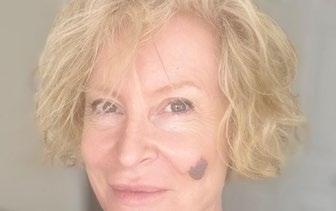


Mr Gerard Lambe MB ChB MRCS MD FRCS (Plast) heads up the Reflect Clinic in Manchester (with satellite clinics across the UK). He is a spokesperson for the industry body British Association of Aesthetic Plastic Surgeons (BAAPS), which focuses on safety and regulations in the cosmetic surgery.
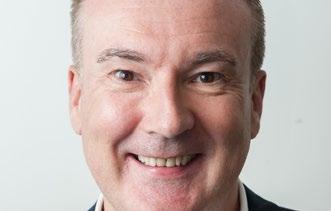
Vicky is an award-winning journalist and editor who has specialised in aesthetics for almost 20 years. She is founding editor of Aesthetic Medicine and edited five supplements for The Times. In 2015, she won a Safety in Beauty Award for supporting standards within the industry.

Piroska has an MSc in Cosmetic Medicine with an interest in tackling facial disfigurement due to injury, illness or surgery with the combination of treatment modalities. She also holds qualifications in obesity and weight management, prescribing and hormone health.
Gary is the founder and CEO of 5 Squirrels, which helps skincare professionals launch their own brand skincare products. Gary is also a consultant to the Society of Cosmetic Scientists, which promotes education and research to advance the science of cosmetics.
Eddie is the founder and chief executive of Hamilton Fraser. He is an expert in the cosmetic insurance sector with more than 28 years of experience. He provides support, advice and education to practitioners on key topics such as aesthetics regulation, legislation, insurance and business growth.



Leading UK consultant surgeon Gerard Lambe asks how much is too much
Following the recent reports regarding model Katie Price undergoing her sixth face-lift and further breast surgery, leading UK consultant surgeon Gerard Lambe, who specialises in safety in surgery and is a member of the Royal College of Surgeons and spokesperson for The British Association of Aesthetic Plastic Surgeons, discusses this growing issue. He leads the Reflect Clinic UK and is a trusted expert in safety in surgery.
Here, he talks about what surgeons look out for when presented with someone with body dysmorphia and/or surgery addiction. It is an issue he and other surgeons in the UK are seeing increasing.
“These latest images of Katie having had yet another cosmetic surgery procedure send out a dangerous message to vulnerable people who may think cosmetic surgery is a low-risk procedure. These latest pictures show she has undergone a further nasal procedure,

on top of ‘tweaks’ to her sixth £10,000 facelift at a clinic in Turkey”, he says.
“I am gravely concerned for Katie as she is clearly showing signs of severe body dysmorphia – something any surgeon can spot quickly upon a consultation. Body dysmorphia is a devastating condition, but constant images of surgery send a damaging message to fans on social media.
“No surgeon should be encouraging this and it is one of the most depressing aspects of surgery tourism we have in that the standards and protections we have in the UK are simply not respected at many overseas clinics. Money comes first and often at the expense of a patient’s mental and physical health.
“There is such a thing as surgery addiction – a compulsion to seek out cosmetic and surgical procedures. It is classified as a behavioural addiction that
impacts a person’s health, mental wellbeing, and, of course, finances.
“Tragically, people with body dysmorphic disorders are more likely to become addicted to plastic surgery - but there are resources available to help anyone recover, and I urge anyone, including Katie, to please seek support.”
“Furthermore, as reported in The Times, cosmetic surgery abroad in places like Turkey, where Katie Price is a regular, is NOT covered on standard travel insurance medical cover”, he adds.
“There are too many stories of botched procedures that have taken place overseas and which surgeons such as myself are called up to fix. Yet, surgery tourists are rarely aware or informed that they need specialist insurance cover should the worse happen.”
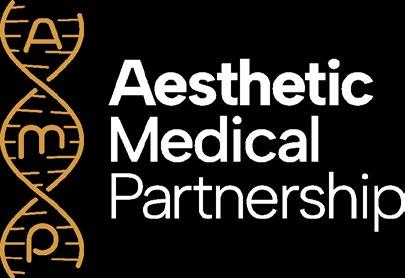
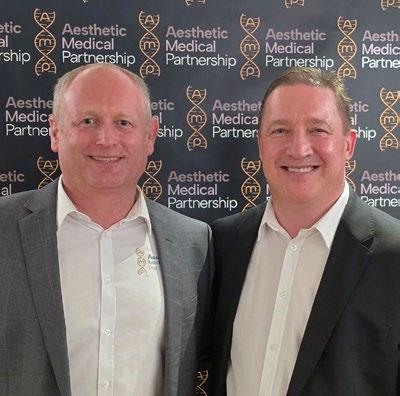
Forming a unique partnership between patient, provider and supplier.
Aesthetic Medical Partnership Ltd (AMP) was founded by industry veterans Martyn Roe and Paul Simmonds to bring innovative regenerative technologies to the UK and Ireland marketplace.
With extensive experience in clinic ownership, distribution, and consultancy, AMP offers cutting-edge, patient-focused solutions designed to help aesthetic practices thrive. Our portfolio features carefully sourced products, with fair pricing and no unnecessary consumables.
We go beyond product supply, offering hands-on support, advanced training, and proven strategies to grow your business. At AMP, we’re committed to building genuine partnerships - because your success is our success.
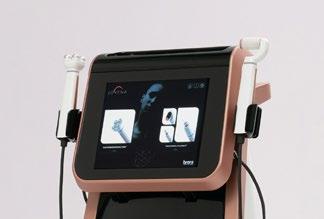
Jovena® is a revolutionary bio-regenerative platform that combines two patented modalities. FaceSTIM an intense facial workout is paired with class leading Fractional Plasma® options. FaceSTIM by Jovena

Alpha is the revolutionary Diode Laser & 3D IPL Combination System. The Alpha system merges cutting-edge technologies into a single,versatile device, opening up a realm of possibilities for your clinic.
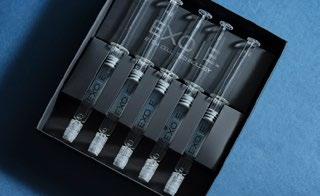
EXO|E Skin Revitalising Complex is an innovative three step skincare line that utilises biomimetic plant stem cell technology to rejuvenate and revitalise the skin, whilst reducing downtime and inflammation.
Cellenis® PRP
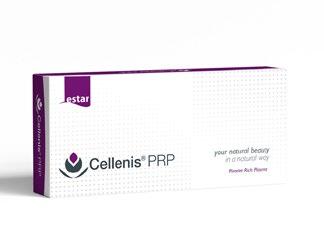
Cellenis® Is the most trusted PRP technology that takes the complexity out of the plateletrich plasma (PRP) preparation process. Its specialised technology separates blood based on density using a unique gel and filter system.
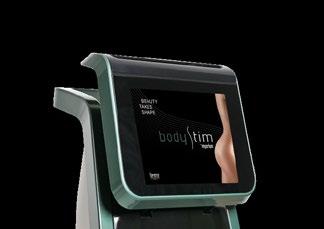
BodySTIM is the combination of two cutting edge technologies using RF Diatermocontraction®. The RF Diathermic Pulse and thermal action combination promotes firming and tightening to multiple areas of the body simultaneously.
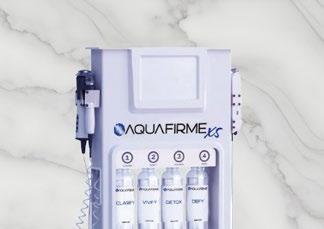
AquaFirmeXS is a second-generation multifunctional dermal health workstation that cleanses, exfoliates, hydrates and nourishes the skin and scalp to treat a variety of concerns. Powered by EXO|E, to deliver Exosomes without needles.
DE|RIVE Hair & Scalp
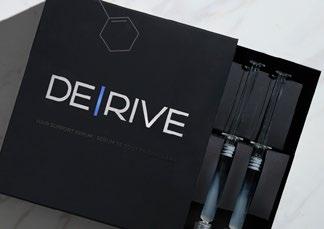
DE|RIVE is a patented 100% plant-based serum, to help improve hair and scalp health. With over 23 medical publications, the ingredients have been researched and are beneficial for all skin and hair types.
Cellenis® DermaFiller

Cellenis® DermaFiller is a 100% natural injectable material which creates an immediate volumising effect that lasts. Its an autologous, biological filler providing extended release of platelet derived growth factors to volumise and regenerate
Contact us today to discuss our product range or to schedule a demonstration. Call 01727 482 432 Email info@amp-uk.co.uk Visit www.amp-uk.co.uk

Independent nurse prescribers across England, Wales, and Northern Ireland are calling for urgent reform of the Human Medicines Regulations 2012, arguing that the current legislation is outdated and places patients and practitioners at risk. Unlike nurses in Scotland, independent nurse prescribers in other parts of the UK are not legally permitted to hold prescription-only medicines (POMs) as stock. This severely impacts the reasonable standard of care in emergency situations and limits the ability of nurses to provide safe, efficient, and effective care at the point of delivery, when patients need it most, according to the British Association of Medical Aesthetic Nurses (BAMAN).

In Northern Ireland, independent nurse prescribers are prohibited from holding emergency stock, despite the fact that medicines are considered mandatory in the management of serious complications in order to ensure patient safety and in some instances, in order to save life. Instead, nurse prescribers are forced to rely on an system, where they must secure prescriptions for each individual patient on a named patient basis when required. These nurses cannot own, hold, or store medicines, which is likely to result in unacceptable and avoidable delays in treatment. This significantly raises the risks to patients in time-critical emergencies and it cannot be allowed to continue due to the known risks.
UK nurses are now calling on the Government and regulatory bodies to:
• Amend the Human Medicines Regulations 2012 to allow independent nurse prescribers to hold stock within strict professional guidelines that can be set out
• Ensure patient safety by allowing nurses to hold stock and thus reduce delays in emergency treatment, such as vascular occlusion reversal and the critical care which is crucial to prevent sepsis
• End the discrimination against nurses in independent practice by removing the impositions placed upon them that is preventing nurses from supporting patients, operating safely and efficiently, and fulfilling their mandatory duty to nurse their patients in accordance with the reasonable standard of care, as their counterparts in Scotland can do.
BAMAN wrote: “The UK government must act now to protect the public, limit patients suffering un-necessarily and to prevent avoidable harm due to an outdated and inequitable system.”

A BBC investigation has revealed a former tattooist who left a woman “looking like a gargoyle” after giving her botched face fillers had been posing as a doctor at his aesthetics clinic. Harley Academy has consistently called for improved aesthetic regulations to keep patients safe and have called for only medical practitioners in regulated environments to be able to deliver these treatments.
Tristan Mehta, founder and CEO of Harley Academy stresses, “The UK urgently needs tighter regulatory frameworks to ensure only medically qualified practitioners can administer treatments. We are calling for swift regulatory action to protect patients and prevent further tragic outcomes. This includes:
Mandatory medical qualifications – All practitioners offering invasive procedures should hold medical qualifications
• Licensing and oversight – Clinics and practitioners must be held accountable through a formal licensing system, ensuring regular inspections and adherence to high standards of care
• Public awareness – Patients must be made aware of the risks and know how to identify qualified practitioners. More needs to be done to educate the public about the importance of seeking out credible, highly trained professionals.
This investigation comes just months after the tragic loss of Alice Webb following a Brazilian Butt Lift (BBL) procedure. Harley Academy are urgently calling on the Government to re-prioritise and support the development of aesthetic industry regulations, being led by the JCCP. “It is clear that the public is at risk and patients have been dying in the months it has taken for the Government to review and implement the recommendations provided by the JCCP on how to improve regulations and make the industry safer”, Dr Mehta adds. ‘’This tragedy is yet another wake-up call to the entire industry and the government, and we hope this spurs them to act now for better regulations.’’

Leading cosmetic insurance provider Hamilton Fraser has unveiled its top 10 aesthetic trends for 2025. They include:
1. Longevity and biohacking in aesthetics
Patients are prioritising healthspan and prevention, leveraging biohacking tools alongside nutrition and lifestyle medicine for a 360-degree approach.
2. The rise of regenerative aesthetics
Regenerative treatments, such as polynucleotides, bio-stimulating fillers, and exosomes, are driving natural, long-term rejuvenation.
3. ‘Less is more’—The end of overfilled faces
Patients are moving away from overfilled looks in favour of natural enhancements.
4. Combination treatments and ‘treatment stacking’ Multi-modal approaches that address diverse concerns simultaneously are now a priority.
5. Advancements in personalisation
Patients are demanding bespoke treatments. From AI-powered skin analysis to personalised hormone therapies, customisation is becoming an essential part of patient care.
6. Weight loss medications
With weight-loss injections gaining popularity, clinics are developing complementary treatments to address skin laxity and facial ageing caused by rapid weight loss.
7. A move towards medicalisation
Increased regulation and the legitimisation of aesthetic procedures as medical treatments are transforming patient safety and industry professionalism.
A major consultation, launched by the Scottish Government on December 20 and closed on February 14 has been seeking the views of members of the public on a new scheme of licencing and regulation for non-surgical cosmetic procedures such as breast and buttock augmentation, liposuction, hair restoration surgery, vitamin infusions, weight loss injections, ablative lasers botulinum toxin injections, chemical peels and dermal fillers.
The proposals outlined in the consultation paper for a new scheme of licensing and regulation would require both a premises and practitioner licence to undertake lower risk procedures, with higher risk procedures restricted to a regulated setting. This would involve possession of both a practitioner licence and a premises licence and will make it an offence for anybody to carry out non-surgical cosmetic treatments without a license (and/or in the absence of proposed systems of regulatory control and professional oversight).
The Scottish Government also asked for public views on the degree to which children and young people should be able to access nonsurgical cosmetic procedures and whether to put in place any age restrictions for such procedures.
The scheme of regulation seeks to ensure that people who administer cosmetic procedures are properly experienced, trained and qualified, have the necessary insurance cover and operate from premises that are clean, hygienic and suitably regulated.
The JCCP has worked closely with colleagues at the Scottish Government and regulatory authorities in the UK to achieve legally enforceable governance arrangements for the cosmetic sector.
8. Advances in botulinum toxin
Innovations in botulinum toxin, including longer-lasting formulations and AI-guided injection techniques, are enhancing precision and results for patients.
9. Hair loss treatments
Hair and scalp health is an emerging focus area, particularly for women and patients experiencing weight-loss-related hair thinning.
10. Women’s health and menopause
A growing focus on women’s health in aesthetics includes menopause management, hormone therapy, and intimate health procedures, reflecting the demand for holistic care at every life stage.
Hamilton Fraser founder and CEO Eddie Hooker commented, “At Hamilton Fraser, we have always championed innovation and safety, and these trends align perfectly with our commitment to elevating standards and enhancing patient outcomes. The integration of wellness, longevity, and advanced technologies is redefining how we view beauty, moving towards treatments that prioritise health, natural results, and overall well-being. The move towards regenerative aesthetics, personalised care, and the medicalisation of treatments underscores the industry’s growing professionalism. With anticipated regulatory advancements and groundbreaking innovations, this is an exciting time for practitioners and patients alike. As we embrace these changes, Hamilton Fraser remains dedicated to supporting the industry through education, safeguarding measures, and fostering a community built on trust and excellence.”
The consultation document was the result of long-term work and collaboration to co-design a new, sustainable system of regulation to protect members of the public.
Professor David Sines CBE, Chair of the Joint Council for Cosmetic Practitioners, said: “In recent years we have seen a massive growth in the number and types of non-surgical cosmetic procedures. Alongside this growth we have seen a dramatic increase in the number of complaints about substandard treatments, unregulated cosmetic products and unsuitable treatment premises.
“This [scheme] will dramatically improve consumer safety and reduce the risk of injury and harm arising from ‘botched’ and improperly performed cosmetic treatments.”
“All too often it is the NHS – and therefore the taxpayer – that has to pick up the pieces when a cosmetic procedure goes wrong. The Joint Council for Cosmetic Practitioners has seen a 400% increase in complaints in the last year alone, so we warmly welcome this important step towards proper regulation. Nothing is more important than public protection and patient safety.”
“I warmly welcome the Scottish Government’s decision to consult on this new, proposed scheme of regulation and licensing. In my opinion the proposals included in this consultation document will dramatically improve consumer safety and reduce the risk of injury and harm arising from improperly performed cosmetic treatments. Nothing is more important than public protection and patient safety”.
“I would urge everybody to support this move towards sensible and proportionate regulation in this important sector”.


Over the next year, Ron Myers, co-founder of The Consulting Room, will be sharing a series of short, three-minute videos packed with insights from his 30+ years in the medical aesthetics industry. Each bite-sized episode explores key topics, offering valuable perspectives and “aha” moments for both new and experienced clinic owners. The first two focus on the history and finances, fortunes and misfortunes, of the largest and longest established non-surgical and surgical aesthetic clinic chains operating in the UK.
They reveal salient points that are important to all clinic owners about profitability, changing consumer demand and the impact that Venture Capital companies have made in their efforts to consolidate this sector. The first video entitled Is BIGGEST always best? A Review of Non-Surgical Medical Aesthetic Clinic Groups, reviews the interesting history of sk:n, formerly the largest non-surgical group in the UK, alongside thérapie which now claims to be Europe’s No.1 medical aesthetic clinic.
The second video – UK Cosmetic Surgery Groups - Boom to Bust? – delves into the cosmetic surgery sector, which existed long before the rise of the non-surgical medical aesthetics market. It explores the history and evolution of key industry players, including Transform Medical, Make Yourself Amazing (MYA), The Harley Medical Group, and The Private Clinic, while also examining where they stand today.
To learn more about Ron Myers and his group coaching service for aesthetic clinic owners, visit: www.ronmyers.co.uk.

The British College of Aesthetic Medicine (BCAM) has announced the appointment of three new Trustees to its board. Dr Haidar Hassan, Dr Ahmed El Houssieny and Dr Deepa Panchalingam will help to achieve the College’s charitable and educational aims.
BCAM president Dr Catherine Fairris said of the new appointments: “I am very pleased to welcome our three new Trustees who I believe will add significantly to the current board. They bring with them a wealth of experience and skill set that we believe will help propel BCAM forward and will support it in its endeavors to continue to be a leading voice in aesthetics, representing doctors and dentists.’ These appointments aim to strengthen BCAM’s leadership and further its mission to advance safe and ethical aesthetic practices.”
The British Association of Medical Aesthetic Nurses (BAMAN) has appointed a new board. Members incliude Anna Baker, Brenda McKibbin and Constance Campion-Awwad, along with Amy Bird as the new chair and Alexandra Mills as vice-chair.
Sharon Bennett who chaired the association for 11 years commented, “BAMAN, previously BACN, was set up by inspiring, determined women, and it has been an honour to be entrusted to be its custodian to safeguard and grow the association. I feel privileged to have been given the opportunities I have had to develop personally. I am reassured that the association will continue to be led by dynamic nurses who will maintain the spirit and ethos in which it started.”
Mills commented: “I’m thrilled to be part of the board of directors at BAMAN, where I am privileged to work alongside strong, inspiring women leaders. I am deeply committed to advancing equality in the medical aesthetics field, ensuring our voices are heard and represented.”
PhilArt is now PolyPhil™ Croma-Pharma®, is re-branding its PhilArt range of polynucleotides to PolyPhil™. This change will enhance the products’ recognition across international markets, reinforcing Croma’s commitment to providing pioneering and effective treatments. Vikki Baker, head of marketing UK IRE NL said, “With the on-going demand for our polynucleotide portfolio, this name change will better encompass what the product does and will broaden reach in all markets, aiding to global brand awareness. The quality and efficacy of the product remain unchanged and Croma UK will dedicate investment and support for this rebrand.”
DermaFocus and InMode announce strategic partnership DermaFocus has announced a strategic partnership with InMode. The partnership will see InMode integrate Purasomes into its portfolio of innovative energybased aesthetic solutions, which include the Morpheus8 and Fractora radiofrequency microneedling devices, the Forma RF, the Lumecca IPL technology and the NEW InMode Allure.
Agenda confirmed for WAS
The first-ever Welsh Aesthetics Symposium (WAS) is set to debut on Saturday March 29 at the ICC Wales in Newport. The carefully curated CPD-accredited agenda covers clinical guidance alongside business advice for a comprehensive day of learning. The morning sessions will delve into critical topics such as patient safety, regulatory standards, and effectively managing complications. The afternoon will shift focus to skin health. Visit welshaestheticssymposium.co.uk
Online course helps aesthetic clinics boost conversion rates Master the Art of Converting Leads with Vanessa Bird is a course that addresses the challenges practitioners and clinics face if they struggle to achieve a return on their lead generation investment. It is designed to help clinics transform enquiries into bookings and boost their revenue. For more information, visit The Aesthetic Consultant’s course page or contact Vanessa directly at aestheticconsultant@icloud.com.

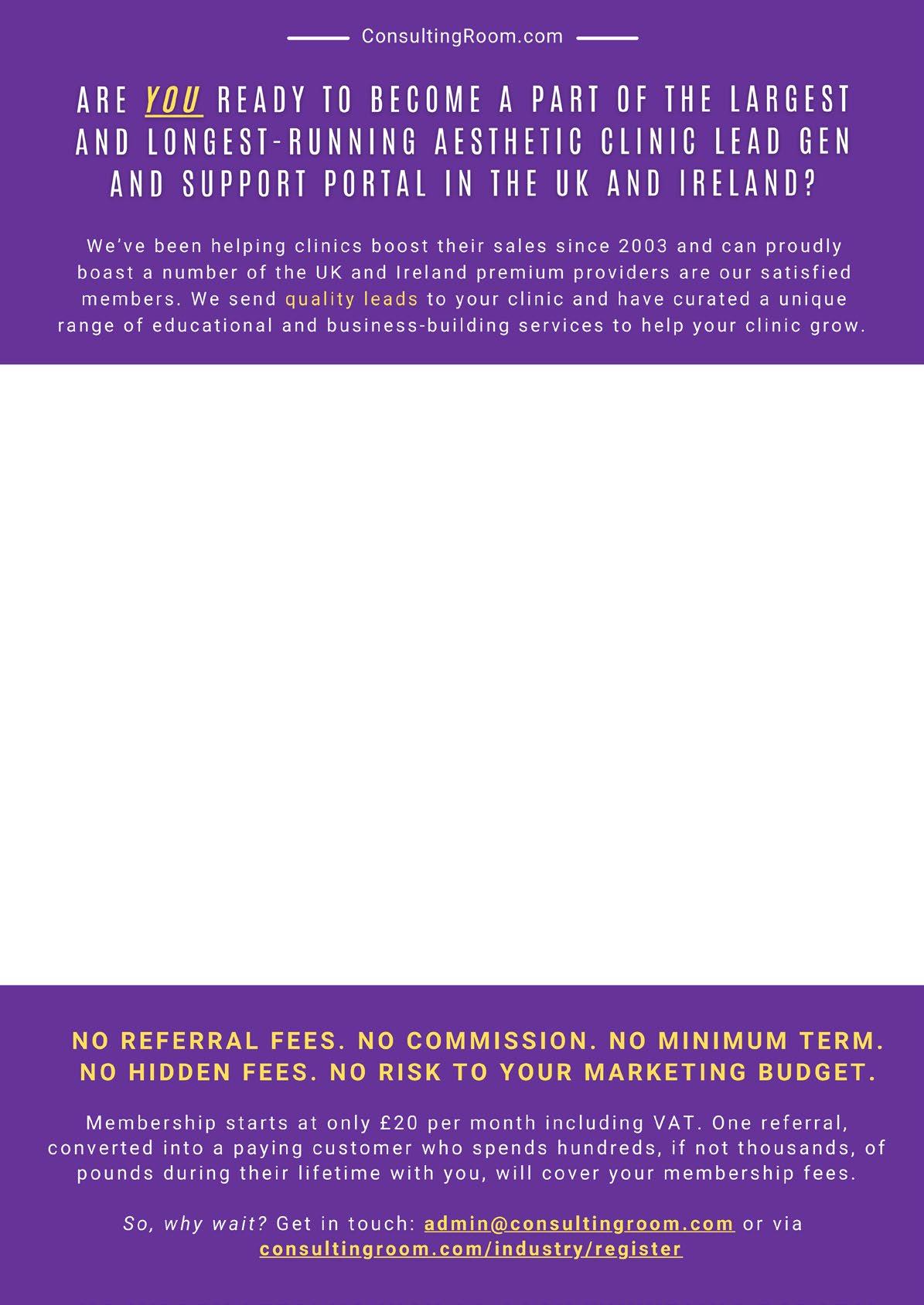
Lead generation with full access to your clinic search stats in your Members Area to monitor performance and achieve your best ROI
Increased web presence and search engine optimisation (SEO)
FREE CPD-certified aesthetician training: The art of the aesthetic consultation
Multiple routes to engage directly with consumers including a public Q&A
Learn to harness the full power of your social media with our FREE online course
FREE certificated training on how to scale up and generate highpaying clinic clients on auto-pilot
FREE certified reception training: Converting calls to consultations with call-handling and CRM training
A clinic page with multiple links to your website/ways for clients to get in touch

Discounted access to ConsultingBot: An intelligent AI chatbot that engages in conversations with visitors to your website to increase sales enquiries and answer queries
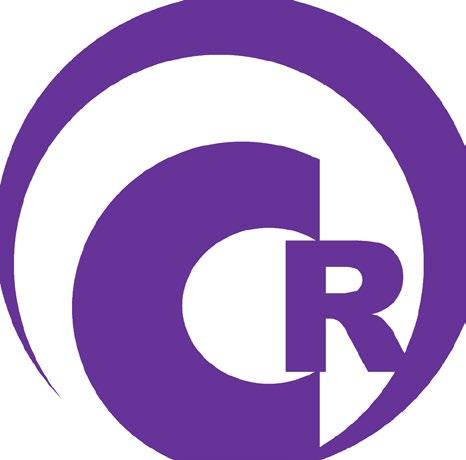
Access CPD-certified articles, educational content and FREE business support
FREE Guidance and template documentation for Health & Safety, Human Resources and Employment Law compliance
Discounted rate for Cosmetic Recruitment services
FREE Unlimited classified advertising for equipment, rooms for lease or even your aesthetic business
Advertise your own training courses and events at a discounted rate
Discounted access to clinic building services and software
Increase your profile through becoming a blog author in our consumer and/or clinic facing blogs
Plus much, much more!
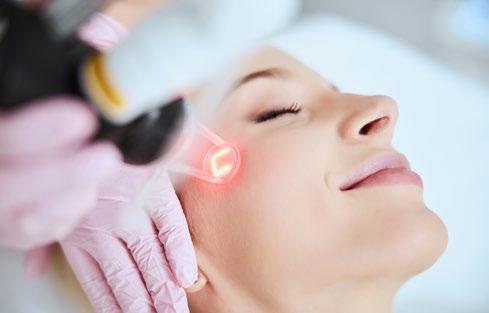
The British Medical Laser Association (BMLA) has advised that aesthetic patients can now use topical retinol up to 24 hours prior to laser treatments.
Previously, the association’s ‘Drugs and Lasers/IPLs guidelines’ stated that retinol use must be terminated two weeks before laser procedures to mitigate unwanted side effects, such as peeling or redness, due to increased skin sensitivity. However, following a review of medical literature and panel deliberations, the new 24-hour timeframe has been implemented.
Despite this, it is not advised that patients start using retinol immediately before starting a course of laser treatments. The association still states that laser treatment should not be performed if the skin barrier appears visibly compromised.
Eden Aesthetics has announced the appointment of renowned aesthetic practitioner Dr Benji Dhillon as JetPeel Key Opinion Leader (KOL). With extensive experience in aesthetic medicine and non-surgical treatments, Dr Dhillon will collaborate with Eden Aesthetics to support the unique JetPeel technology industry education as well as launching the Eden Aesthetics JetPeel PR showcase at the Define Clinic, Fitzrovia.

Dr Dhillon will play a pivotal role in educating practitioners on Eden Aesthetics’ portfolio of advanced skincare technologies. His expertise will enhance clinical training and drive awareness of scientifically backed, results-driven treatments offered by Eden Aesthetics.
He said, “I am delighted to partner with Eden Aesthetics, a company that shares my commitment to excellence in aesthetic medicine. Their dedication to providing evidencebased, high-performance skin treatments aligns with my philosophy of delivering the best possible outcomes for patients”.
New research published in the British Journal of Dermatology has found that applying a common food additive to hair follicles can activate taste receptors and prevent hair growth in lab tests. Researchers from the USA and Germany found that human scalp follicles, the tiny biofactories that produce hair, have a bitter taste receptor called TAS2R4. When stimulated with a natural, stevia-like sweetener, rebaudioside A (or Reb-A), the taste receptor sends signals to the follicles that suppress hair growth.
Professor John McGrath, Editor-in-Chief of the British Journal of Dermatology, said, “We don’t know for sure that activating these taste receptors in hair follicles could reduce hair growth in people – but it’s the type of research that could one day lead to a new type of hair removal product. The concept is that activating the receptors alters the way a hair cycles through its growth phases, promoting what is known as ‘apoptosis’, where the hair follicles start to die, stopping hair growth in its tracks. So far, the research has been conducted on donated human scalp skin from hair transplant and facelift patients – an important step will be to see if the findings can be repeated in clinical trials on humans rather than just isolated hair follicles.”
Galderma reports positive interim results for volume loss
Galderma has announced encouraging interim results from its innovative clinical trial assessing the effectiveness of Restylane Lyft or Contour in combination with Sculptra for patients experiencing facial volume loss due to medication-driven weight loss. The three-month data suggests significant improvements in facial aesthetics, with high levels of patient satisfaction.
MP to introduce bill protecting nurse title
MP for Brent East Dawn Butler has proposed a bill in Parliament that would protect the title of “nurse”. Under the House of Commons’ 10-minute rule, she presented the bill that, if supported and made into law, would prevent someone from operating under the title of “nurse” unless they are on the Nursing and Midwifery Council (NMC) register. Currently, it is illegal for someone to call themselves a “registered nurse” without the relevant qualifications, but the title of “nurse” alone is not protected by law.
Newcastle upon Tyne is city most concerned about hair loss
A study by Aventus Clinic has identified the top 10 UK cities where residents are most concerned about hair loss. Newcastle upon Tyne ranked top, with nearly 11% of its population searching for hair loss solutions, followed by Bolton and Wolverhampton. The research analysed search volume data for key hair loss-related terms, revealing which areas have the highest relative interest in hair restoration solutions.
Only a third of women feel it’s necessary to wear sunscreen 65% of women feel it’s not necessary to wear sunscreen in hot or sunny conditions, according to research by skincare brand Hada Labo Tokyo. The study also revealed eight in 10 (79%) were concerned about the sun’s impact on skin ageing, with 91% of women knowing that the sun can cause skin damage. Only a third (32%) of women actively avoid the sun and four in 10 do not reapply sunscreen after exercising outdoors or playing sports in the sun.

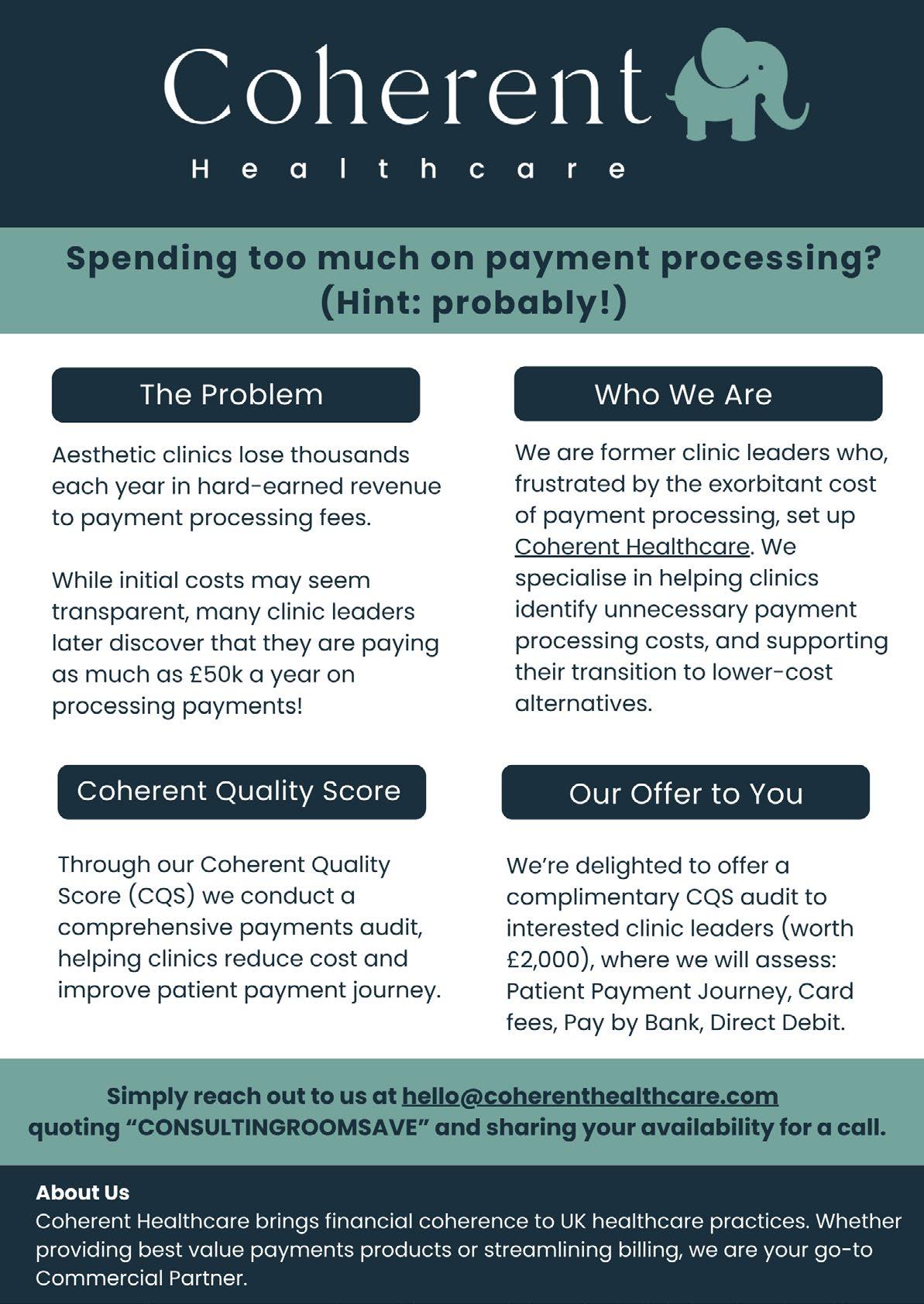
De Vere Grand Connaught Rooms, Covent Garden
Menopause in Aesthetics 2025 (MiA) wrapped up another hugely successful event, marking a milestone in menopause education. With an energycharged atmosphere, sold-out conference sessions, and a packed exhibition floor, this year’s meeting exceeded expectations, bringing together leading experts, healthcare practitioners, and industry innovators at the historic Grand Connaught Rooms in London.
One of the standout highlights was the introduction of a new panel discussion format, which received hugely positive feedback from delegates. This innovative approach stepped away from a presentation-based format to provide a fresh, multidisciplinary perspective on key menopause-related topics, reinforcing the importance of diverse insights in advancing women’s health.
The event is now evolving under a new name: Menopause in Practice (MiP). This rebrand reflects a broader and more inclusive vision, opening the doors to a wider range of healthcare professionals involved in menopause management beyond just aesthetics.
This change aligns with the launch of Future Patient, a new quarterly digital publication from mBody Media, set to debut in Spring 2025, which will focus on health, wellness, and longevity.
Returning to the Grand Connaught Rooms in London on February 6, 2026, MiP will continue to offer cutting-edge educational content, expert speakers, and an expanded exhibitor line-up, ensuring that delegates gain unparalleled insights into menopause care and management.
De Vere Grand Connaught Rooms, Covent Garden


The inaugural Menopause in Aesthetics Awards took place on the evening of Menopause in Aesthetics. The evening was hosted by editor Vicky Eldridge and actress Leanne Stott.
The awards recognised contributions to menopause care across the aesthetics and healthcare sectors. Among the winners were Dr Shirin Lakhani, who got an Outstanding Achievement award and took home the title of Clinic of the Year South for Elite Aesthetics; The Door W4, which won Clinic of the Year London; eJoli Clinic, which won Clinic of the Year North; Temple Clinic, which won Clinic of the Year Scotland; Tracey Dennison, who won Nurse of the Year; and Dr Hazel Parkinson, who won the title of Menopause Specialist (Doctor) of the year and Best Patient Case Study.




Home House, Portman Square
The Pause Live team marked International Women’s Day with a press and influencer event at London’s Home House.
The day provided networking opportunities for media and brands in the women’s health space. It also saw the launch of Pause Live’s #IAmEveryWoman campaign, championing women at all stages of life, from menstruation to menopause, alongside panel discussions.
Pop sensation and women’s health advocate Sinitta spoke on the launch and EveryWoman campaign: “I love the concept, I love the idea, I am very proud, and I think the team are incredible. I love the fact that we are still learning as we empower each other, which is fantastic. Women for women, right!”



Claridge’s, Mayfair
W-Wellness, the UK’s first expert-led wellness e-commerce platform, showcased 2025 Wellness insights with an expert panel of over 85 practitioners, industry influencers and aesthetic media.
The evening opened with a champagne and canapes reception before a welcome by W-Wellness co-founders Sally Lefever-Bell and Sophie Woodward. As one of the key missions of W-Wellness is to keep its expert community at the forefront of a rapidly evolving and overwhelming supplement and health solutions space, the panel took a deep-dive into what wellness means today and discussed longevity, gut health, fertility and aesthetics.
Francesca Ogiermann-White, founder of The Beauty Triangle and Tatler’s Health & Beauty Editor-at-Large, chaired a panel talk where she was joined by experts Dr Elena Antonova, Liberty Mills, Dr Nichola Conlon and nurse Yasmin Shirazi.
Together, they discussed key trends covering how to rejuvenate and regenerate skin at a cellular level, the increase in stress, insomnia and selfesteem, “female burnout” aka a physical, emotional and mental exhaustion that can be compounded whilst navigating life chapters such as menopause, infertility, and how the worlds of aesthetics and regenerative medicine overlap aesthetics as a form of wellness.




The Grove, Watford
Editor Vicky Eldridge was among the guests at this year’s InMode International Women’s Day celebration at the exclusive Grove Hotel. Members of the press joined industry professionals for a day celebrating women’s achievements and discussing beauty, wellness, and self-care.
The day began with breakfast, coffee and a chance to catch up, followed by a panel exploring topics such as burnout and intimate health. Guests then got a chance to take part in some self-development and reflection before a delicious three-course lunch. The afternoon featured discussions on combining tech and touch, using the brand’s new Allure technology and a chance to sit back and relax with a sound bathing session.
In the evening, everyone got dressed up for a formal dinner and networking drinks with entertainment. For those staying over, there was a chance to enjoy the luxury spa facilities the next morning before heading home armed with a beautiful bouquet of flowers.



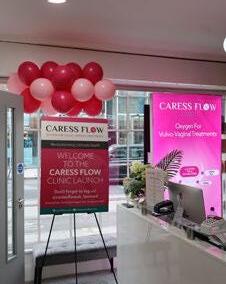
Vie Aesthetics, London
Caress Flow made its UK debut at Vie Aesthetics in Holborn, marking the launch of its first flagship clinic. The exclusive event introduced press and clinic owners to the groundbreaking device that is set to redefine vaginal health treatments with its non-invasive, painless technology.
The launch event commenced with a presentation by the team at Lawmed, the official distributor of Caress Flow in the UK. A dynamic Q&A session followed, with presenter Sarah Cawood, who has personally experienced the benefits of Caress Flow as a case study. Sharing her journey, Cawood described how the device has significantly improved her intimate health, reinforcing its credibility and effectiveness. Guests then had the opportunity to network over drinks while witnessing live demonstrations of the device in action.
Spaces & Stories, London
On March 6, Human Health Professionals successfully launched its inaugural training event, redefining how aesthetic clinicians integrate healthgevity and metabolic wellness into their practices.
Led by Dr Mayoni Gooneratne, the event featured expert-led workshops, actionable strategies, and networking opportunities. Attendees gained valuable insights into functional medicine and its role in aesthetic treatments, ensuring a more holistic approach to patient care. Clinicians left feeling empowered with the knowledge and confidence to bridge aesthetics with wellness, reinforcing the future of patientcentred, transformative care.


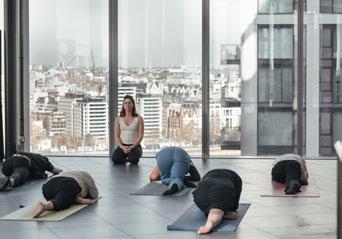






In this section
• Safety in Aesthetics launches
• The consultation
• Remote prescribing
• Harley Academy
• Menopause safeguarding
• Point of view



Introducing you to our new initiative
The Consulting Room has joined forces with the Joint Council for Cosmetic Practitioners (JCCP) and Hamilton Fraser to launch a new initiative – Safety in Aesthetics.
Our mission is to provide the public with all the information they need to make safe and informed decisions when choosing an aesthetic practitioner. Every clinic listed on the site is accredited, professionally trained, and properly insured, ensuring they prioritise your well-being above profit.
In today’s fast-evolving world of beauty and medical aesthetics, making informed decisions about the professionals we trust with our care is more important than ever.
The rise of non-surgical cosmetic treatments has opened up a realm of possibilities for enhancing one’s confidence and appearance. However, with increased accessibility comes the pressing need to ensure safety remains at the forefront of every treatment.
1. Raise awareness
Highlight the critical importance of choosing qualified and accredited professionals for cosmetic procedures. Look for professionals registered with recognised organisations like the Joint Council for Cosmetic Practitioners (JCCP) or those holding certifications in specific treatment techniques. Prioritise practitioners with medical training and verifiable experience in aesthetics.
2. Educate consumers
Provide accessible, trustworthy information about the dangers of unregulated treatments and the potential consequences
of prioritising price over expertise. For instance, individuals undergoing treatments from untrained practitioners risk complications such as infections, nerve damage, or unsatisfactory results. Recent studies indicate that cases of botched procedures have increased significantly in regions where regulations are less enforced, underscoring the importance of thorough vetting.
3. Encourage vigilance
Equip individuals with the tools and questions to confidently assess the credentials of their chosen practitioner. For example:

• Ask whether the practitioner is registered with a recognised regulatory body.
• Request evidence of their training in the specific procedure you are considering.
• Inquire about their professional insurance.
• Additionally, use online tools such as official accreditation registers or practitioner review platforms to verify their qualifications and reputation.
Safety in Aesthetics underscores our shared commitment to promoting public health and safeguarding the well-being of individuals seeking aesthetic enhancements. By making safety a priority, we can collectively reduce the risks and foster trust in the medical aesthetics industry.
The JCCP said: “Ensuring patient safety is fundamental to ethical aesthetics. The JCCP endorses Consulting Room’s Safety in Aesthetics initiative, providing healthcare professionals with expert guidance, resources, and a supportive network. Subscribing is a step towards demonstrating a commitment to safe, ethical practice and industry integrity. Commit today — subscribe for FREE.”
https://www.consultingroom.com/safety-in-aesthetics/find-out-more/





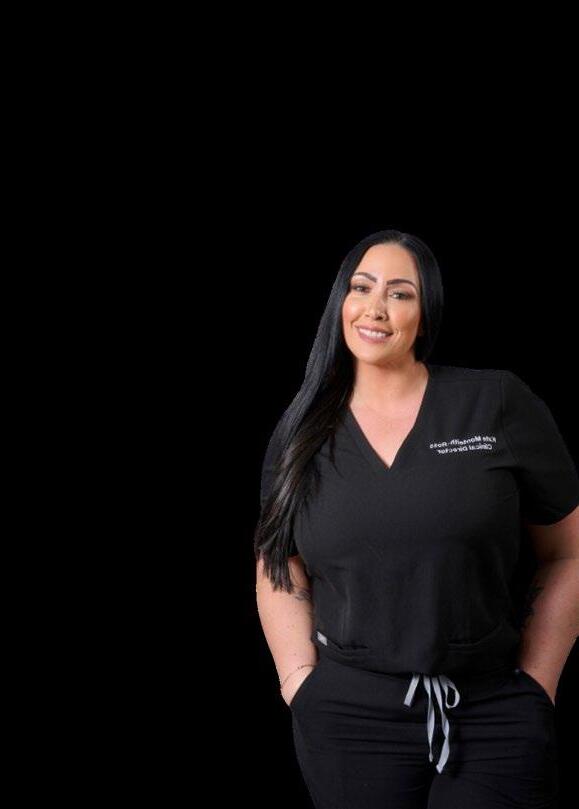



While in the right hands and with the right products, aesthetic treatments can provide excellent results, patient safety must remain the highest priority.
A thorough consultation process is essential to ensure that treatments are appropriate, risks are minimised, and ethical standards are upheld.
In this article, we explore the key aspects of consultation in medical aesthetics, including identifying red flags, knowing when to refuse treatment, maintaining accurate records, and signposting patients when necessary.
Aesthetic practitioners must be vigilant in identifying red flags during patient consultations. These may indicate that a patient is unsuitable for a particular treatment or may require further assessment. Key red flags include:
• Unrealistic expectations – Patients expecting extreme or unachievable results may be dissatisfied with the outcome, leading to potential complaints or psychological distress.
• Body Dysmorphic Disorder (BDD) – If a patient exhibits signs of BDD, such as excessive preoccupation with perceived

flaws or dissatisfaction despite previous treatments, they should be referred to a mental health professional before proceeding.
• Medical contraindications – A full medical history must be taken to identify any contraindications such as allergies, bleeding disorders, autoimmune conditions, or medication interactions that may increase the risk of complications.
• Frequent treatment requests – Patients who seek repeated treatments within short timeframes may be developing an unhealthy dependency on aesthetic procedures.
• Pressure or coercion – If a patient appears to be under pressure from another person to undergo treatment, it is essential to ensure they are making an independent decision.
Ethical and responsible aesthetic practitioners must recognise when to refuse treatment. Saying “no” is often necessary to protect the patient and maintain professional integrity. Scenarios where treatment should be declined include:
• When the treatment is not in the patient’s best interest
• When a patient has a medical or psychological condition that makes the procedure unsafe
If the patient is underage or lacks the capacity to provide informed consent
• When the practitioner lacks the necessary training or experience for the requested procedure
• If the patient is exhibiting aggressive or threatening behaviour.
Declining treatment should always be done professionally, and compassionately, with a clear explanation to the patient about why the procedure is not appropriate.
Accurate documentation is a fundamental aspect of patient safety and the consultation process in medical aesthetics. Proper recordkeeping provides legal protection for both the practitioner and the patient while ensuring continuity of care. Essential aspects of medical record-keeping include:
A detailed medical history and patient assessment
• Documentation of the consultation, including treatment goals, risks, and alternative options discussed
• Informed consent forms signed by the patient
• Before-and-after photographs to track treatment progress
• Clear documentation of the treatment plan, including products used, dosages, and injection sites
• Notes on follow-up care and any complications that arise post-treatment.
Maintaining well-organised records ensures that practitioners can justify their clinical decisions and provide safe, ethical care.
When a patient is not suitable for an aesthetic procedure, it is crucial to direct them to the appropriate alternative services. Signposting helps maintain ethical standards and ensures that patients receive the care they need. This may include:
• Referring patients with suspected BDD or significant psychological concerns to mental health professionals
• Advising patients with skin conditions to see a dermatologist instead of proceeding with aesthetic treatments
• Directing patients with medical contraindications to their general practitioner for further evaluation
• Suggesting alternative non-invasive skincare treatments when injectables are not suitable.
Signposting should always be done with sensitivity, ensuring that the patient feels supported and informed rather than rejected.
The consultation process in medical aesthetics is a critical component of patient safety. Identifying red flags, knowing when to refuse treatment, maintaining meticulous records, and signposting patients to appropriate care providers are all essential responsibilities of an ethical, aesthetic practitioner. Prioritising patient welfare not only protects individuals from unnecessary risks but also upholds the reputation and credibility of the medical aesthetics industry. Practitioners who conduct thorough consultations will foster trust with their patients and contribute to safer, more ethical aesthetic medicine practices.


In January 2025, the NMC Fitness to Practise Committee addressed (and published) misconduct allegations against Registered Nurse Heather Hazzard, including improper prescribing, failure to verify qualifications and dishonesty. The Registrant admitted to all charges in a Consensual Panel Determination (CPD) agreement and did not attend the hearing. The panel, chaired by Lucy Watson, imposed a striking-off order, citing the misconduct’s severity and its impact on public trust and safety.
The JCCP later published its thoughts on the issue, saying it “welcomes the robust response from the Nursing and Midwifery Council (NMC) relating to the expected standards when prescribing for cosmetic procedures.”
It added: “As a professional statutory regulator, this is an authoritative determination which we believe has important implications for safe and legal practice across the cosmetic sector.”
They went on to highlight several key findings in this case, reminding those who prescribe and delegate Prescription Only Medicines (POMs) in the cosmetic sector and those to whom the procedures are delegated of their duties and responsibilities. This outcome should also assist those with a responsibility for enforcement in relation to public safety, including Environmental Health Officers, regarding the standards they should expect to find.
“The JCCP has long held concerns about the standard of prescribing in the cosmetic sector and the inappropriate supply of POMs”, they wrote. “We have engaged with the professional regulators widely and the NMC specifically to reach a consensus across all prescribing professions to identify the common ground for prescribing standards, particularly in relation to remote prescribing. The JCCP prescribing guidance (2019) has already benefited from professional regulator review, and we believe that it represents this common ground. Its focus on prescribing for cosmetic procedures provides important direction

for prescribers and non-prescribing practitioners to practise safely, to protect those in their care and to avoid personal and professional sanction. It has further formed the basis of the JCCP’s engagement with professional regulators, including NMC, with a view to restricting remote prescribing for cosmetic procedures. The following determinations (italics) set out by the NMC align with the advice provided by the JCCP.”
Below are a number of key findings, alongside the JCCP’s headline guidance, as a reminder for those dealing with prescriptions in the cosmetic sector.
9. The consultation should take place faceto-face to allow the prescriber to examine the patient’s skin and muscles to determine suitability. The NMC’s publication entitled ‘Useful information for prescribers’ states that remote prescribing is unlikely to be suitable for injectable cosmetic treatments. The NMC’s publication is also supported by the Joint Council for Cosmetic Practitioners – Responsible Prescribing for Cosmetic Procedures -2019 (‘JCCP’) which advises that remote consultations are not acceptable, and highlights that it is good practice for face-to-face consultations to take place before prescriptions are issued.
10. Guidance set down by the Royal Pharmaceutical Society, framework adopted by the NMC, the JCCP and the Cosmetic Practice Standards Authority (‘CPSA’) sets out their decision not to endorse or permit the remote prescribing of any prescription medication when used for specifically nonsurgical cosmetic treatments.
The prescriber retains overarching and ongoing responsibility.
11. The JCCP states that when the prescriber delegates treatment to other practitioners, the patient remains under the oversight of the prescriber, requiring the prescriber to be familiar with the patient through an initial fact to face consultation and diagnostic assessment of the patient’s suitability for treatment.

The prescriber must only delegate a procedure after an assessment of competence.
13. Prescribers are responsible for the decision to supply medication and remain responsible and accountable for any prescription signed, or any subsequent adverse event or complication. Before prescribing for a non-prescriber, the prescriber has a responsibility to ensure that the non-prescriber is trained to the appropriate standard i.e., competent and proficient to administer the medication prescribed. They should do this by e.g., requesting a copy of the non-prescriber’s insurance policy and training certificate(s) for the treatment, and physically overseeing the first few treatments completed by the non-prescriber.

The prescriber must prescribe (and provide directions for) only what is required for the individual’s needs to meet the indications specified in the consultation.
17. Patient Specific Directions (‘PSDs’) are a legal method of prescribing and detail what a prescriber is required to do when they delegate the administration of POMs to non-prescribers. PSDs are individually tailored to the needs of a single patient and must be produced each time a prescriber prescribes for a non-prescriber. They should include information to enable safe supply and/or information of medicines and manage identified risks.
18. Prescribing nurses should only be prescribing enough medication for each individual patient. If there is leftover Botox after treatment it is permissible to retain it
for use on the same patient, before expiry. Retaining Botox that has been prescribed for one patient and using it on another, and/or using single-use prescriptions for more than one patient negates the need for an additional PSD. Without a separate PSD, it indicates that the patient for whom the Botox had not been prescribed has not had the mandatory consultation with and/or assessment by the prescriber to confirm that the patient is suitable for treatment and/or if there are any contraindications that need to be managed.
The JCCP concluded: “The JCCP is familiar with prescribing platforms that serve to introduce prescribing and non-prescribing practitioners. The activity that arises from their use is found to be too frequently the source of concern and challenge by Environmental Health Officers nationally. We remind prescribers who operate through such platforms that their first responsibility remains with their
professional regulators, irrespective of the policies and procedures implemented by the platform.
“We advise those who are concerned with the use of prescription medicines in the cosmetic sector to review the full NMC publication which includes additional detail and important information relating to, for instance, the importance of manufacturer recommendations.”




Harley Academy, the UK’s leading postgraduate training provider of higher education, has announced the launch of its Global Evidence Matrix (GEM) – the first standardised, evidence-based guide to carrying out injectable treatments for aesthetic medicine professionals.
Speaking at IMCAS Paris in January, Dr Tristan Mehta, founder of Harley Academy, highlighted GEM’s role in driving product innovation, enhancing safety protocols, and delivering transformative training to shape the future of aesthetic practice at the Prollenium Medical Technologies symposium. From February 2025, Harley Academy will oversee the full rollout of the GEM and is thrilled for practitioners to leverage this innovative tool to enhance their practice, foster learning, and strengthen safety measures.
Dr Mehta comments, “The Global Evidence Matrix represents a pivotal moment for our industry. GEM is more than just a framework; it’s a commitment to patient safety, clinical excellence, and the consistent delivery of natural, balanced results. By creating a universal standard, we’re not only empowering practitioners to elevate their skills but also ensuring patients around the world receive the highest quality of care. This is the future of medical aesthetics, and we are incredibly excited to lead the way with Harley Academy.”
The GEM framework is crafted to provide consistent, sciencebacked guidelines for evaluating, standardising, and applying evidence across the aesthetics industry internationally. Based on research carried out by Harley Academy’s Academic Director, the globally renowned anatomist and researcher Professor Sebastian Cotofana, the GEM aims to provide a robust, universal standard for safe injecting.
“Based on our recent research findings, this innovative curriculum integrates injector competencies, anatomic knowledge, and scientific evidence,” says Professor Cotofana. “I am confident this system will empower injectors globally to enhance their practice, ensuring safety and excellence in patient care.”
GEM aims to enhance patient safety, improve treatment outcomes, and support aesthetic practitioners in delivering balanced, naturallooking results across diverse regions. By collaborating with industry leaders, Harley Academy will showcase how products can be used effectively within GEM principles, setting a new benchmark for quality in the industry.
Through GEM, Harley Academy aims to equip trainees and practitioners not only with advanced anatomical and practical skills but also with the knowledge and confidence to choose the best products that deliver outstanding, safe results for their patients. Dr Mehta comments, “We’re thrilled to lead this transformative step forward in aesthetic education and patient care.’’
Harley Academy has collaborated with industry leaders to introduce GEM internationally; the latest partners include Prollenium Medical Technologies and Sinclair, who join Allergan, Croma and HA Derma as key partners of Harley Academy.
Ario Khoshbin, founder of Prollenium, says, “The partnership between Prollenium and Harley Academy represents an exciting opportunity to collaborate in advancing our shared commitment to delivering safe and effective facial aesthetic outcomes. Through a robust educational framework grounded in evidence-based anatomical knowledge and refined practical techniques, this collaboration aims to set new standards in aesthetic education and patient care.”
In our 2025 trends report, women’s health was identified as one of the key growth areas for aesthetics. We predicted that “the demand for not only intimate health procedures but addressing the impact of hormones on women’s overall health (and skin) will continue to rise”, and a big part of this picture is menopause.
As awareness grows and more and more clinics recognise the importance of holistic care that extends beyond traditional treatments, so does demand, making this an ideal time for aesthetic clinics to integrate menopause services into their offerings.
But while this presents an exciting business opportunity, extending services into the menopause space needs to prioritise the patient at its core, and considerations should be given to topics like safeguarding, regulation (are you CQC registered if you are providing certain services?), and scope of practice.
Hamilton Fraser has been proud to partner with Menopause in Aesthetics (now rebranding as Menopause in Practice), and at its 2025 event, I sat on a panel entitled “Becoming a menopause first responder: The business case for introducing menopause services into your aesthetics practice.”
In this article, I will explore the key considerations if you are thinking of becoming a “menopause first responder”.
Menopause has long been an underserved area of healthcare. Many women experience a wide range of symptoms, including skin concerns, weight fluctuations, and hormonal imbalances,

yet they struggle to find knowledgeable professionals who can address their needs holistically.
One of the critical elements of adding menopause services to your practice is compliance with regulatory standards. For example, if you are offering regulated treatments such as HRT, medical weight loss or intimate health procedure, you must be CQC registered.
Safeguarding is another key consideration. Safeguarding is vital to protect both patients and practitioners. As the aesthetics sector expands into sensitive areas such as menopause care, gaps in safeguarding policies and training are becoming increasingly apparent. We carried out a survey to assess what some of these gaps were. It showed:
• 74.19% of respondents had not received formal safeguarding training specific to intimate health treatments, though all (100%) expressed interest in receiving it
• Only 48.3% felt their training adequately prepared them to handle safeguarding issues, with 24.1% stating it did not and 27.6% being unsure
• More than half (54.8%) of respondents confirmed their workplace has clear safeguarding policies for intimate health treatments. 35.4% stated their workplace lacks such policies, while 9.67% were unsure
• 65.5% have a safeguarding lead in their workplace, but 27.6% do not, and 6.9% were unsure.
In addition to the above, proper documentation and patient communication are essential to mitigating legal risks.

Most claims we see arise due to a lack of communication between the patient and the practitioner, so my advice is to spend more time consulting, make sure you take thorough notes, and let patients fully understand their treatment options before making a decision.
Another key element of adding menopause services to your clinic is having the right insurance coverage.

To support practitioners venturing into this field, Hamilton Fraser has created a groundbreaking new insurance offering designed for aesthetic medical professionals providing menopause advice. Launched on 7 February 2025, this policy extension under the Hamilton Fraser Medical Malpractice policy, underwritten by Hiscox, covers consultations, prescriptions, and hormone replacement therapy (HRT) advice.
Key features of this new insurance extension include:
• Eligibility: Exclusively available to
existing Hamilton Fraser insurance customers, primarily targeting doctors and nurses. Referrals from other segments may be considered on a case-by-case basis
• Scope of cover: Includes advice on menopause care, consultations, and prescriptions. Note that it’s designed for advice, not treatment
• Application process: Practitioners will complete a detailed question set. A “yes” to all qualifying questions enables access to the add-on
The aesthetics industry is rapidly evolving. A decade ago, menopause treatments were
hardly discussed in clinics. Most women relied solely on their GP or didn’t recognise the conditions they were experiencing. But times are changing, and insurance providers like us are stepping up to meet these new demands.
Our job is to protect practitioners and, in turn, their patients. The menopause add-on is designed to provide tailored protection so that practitioners can confidently offer advice on menopause care while safeguarding their business.


Piroska Cavell discusses the delicate balance between ageism and aesthetic treatments
“A better, stronger, more beautiful, perfect you”. Does this phrase sound familiar? Many of us have used this, or a version of this message in our marketing.
There have been two brilliant films released recently starring some stunning older female icons: Demi Moore, Pamela Anderson and Jaimee Lee Curtis. A trio of strong, successful women who promote a fabulous natural look, giving them an agedefying appearance without distortion.
However, we know that great aesthetic treatments have been carried out.
Demi is in the astonishingly brilliant film The Substance, where the promise is that individuals need to become “A more beautiful, stronger, perfect version of you”.
The Last Showgirl, starring Pamela Anderson and Jamie Lee Curtis, emphasises that in spite of talent and experience when the physical appearance shows signs of ageing, certain careers will be deemed no longer suitable.

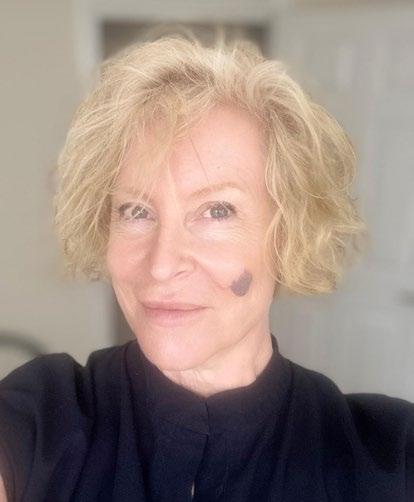
Today, the advances and focus are shifting in medical aesthetics from treating just the ageing skin of the face to enhancing the body, including intimate areas, to menopause, weight loss, longevity and lifestyle medicine. We have to ask are we perpetrators of marketing ‘The Substance?’
I, for one, am not comfortable as a woman and as a medical practitioner encouraging patients to find fault with themselves and develop self-loathing to a greater or lesser degree. Is this what we are manipulating our patients to believe with our marketing messages?
As ethical medical practitioners, we need to develop an awareness and consider what is our role in women’s selfperception. What are we actually saying to patients?
There is a wealth of scientific evidence highlighting the impact of media in all forms contributing to increased societal pressures to look younger for longer, that to show signs of ageing indicates the end of so many important areas of life, including relationships, careers, and a loss of relevance. The film The Substance goes on to examine the self-destructive development of an obsessive pursuit of this unrealistic goal.
Are we encouraging our patients to begin this impossible journey?
We know that our patients are vulnerable to these kinds of messages, and, whilst we are aware of the importance of identifying body dysmorphia, the subconscious message within aesthetics marketing is very often the same as in The Substance and, therefore reinforcing the message from The Last Showgirl.
Are we responsible for encouraging our patients, the majority of which are women, to feel this way? Is our marketing preying on our patient’s insecurities? As medical aesthetic practitioners we need to examine closely our marketing messages.
These films have also triggered a kneejerk response, which I did not anticipate, which is the antagonising of the sector of society who condemn, mainly women, for having aesthetic treatments and also the practitioners providing them. Individuals who are anti-aesthetics and deride women
and men for having treatments. I myself have experienced this with some of my clinic posters being defaced with slogans such as “ Body Fascist” scrawled across them and “JUST BE YOU”.
Alongside the evidence of the impact on women from social media messages encouraging the pursuit of perfectionism. There is also a wealth of evidence confirming the importance of self -satisfaction with an individual’s reflection, has on good mental health and the positive benefits aesthetic treatments can have on a patient’s depression, anxiety and self-confidence.
As medical aesthetic practitioners, we promote ourselves as highly trained, skilled practitioners, and our patients are reassured that as medical practitioners, we are obligated to uphold our code of ethics. We know that patients react differently towards medical professionals. Our patients are more inclined to trust us purely because we are medical, and our messages relating to their well-being and what we can offer them hold more gravitas than in other industries.
As a medical aesthetic practitioner with a business to maintain and grow, emotive marketing messages are key in attracting patients into your clinic and showcasing innovative treatments to stem the signs of ageing from the inside and out.
Careful marketing promoting self-love and body positivity is possible. Messages reinforce how fabulous the body and skin are, highlighting how we, as medical aesthetics practitioners, can reveal patients’ best features to them and build confidence and trust.
I am passionate about boosting patients’ confidence in themselves, not just in their treatments. In my clinic, our efforts are focused not just on technical knowledge and skills but also on encouraging all patients to develop a more positive mindset related to their reflection.




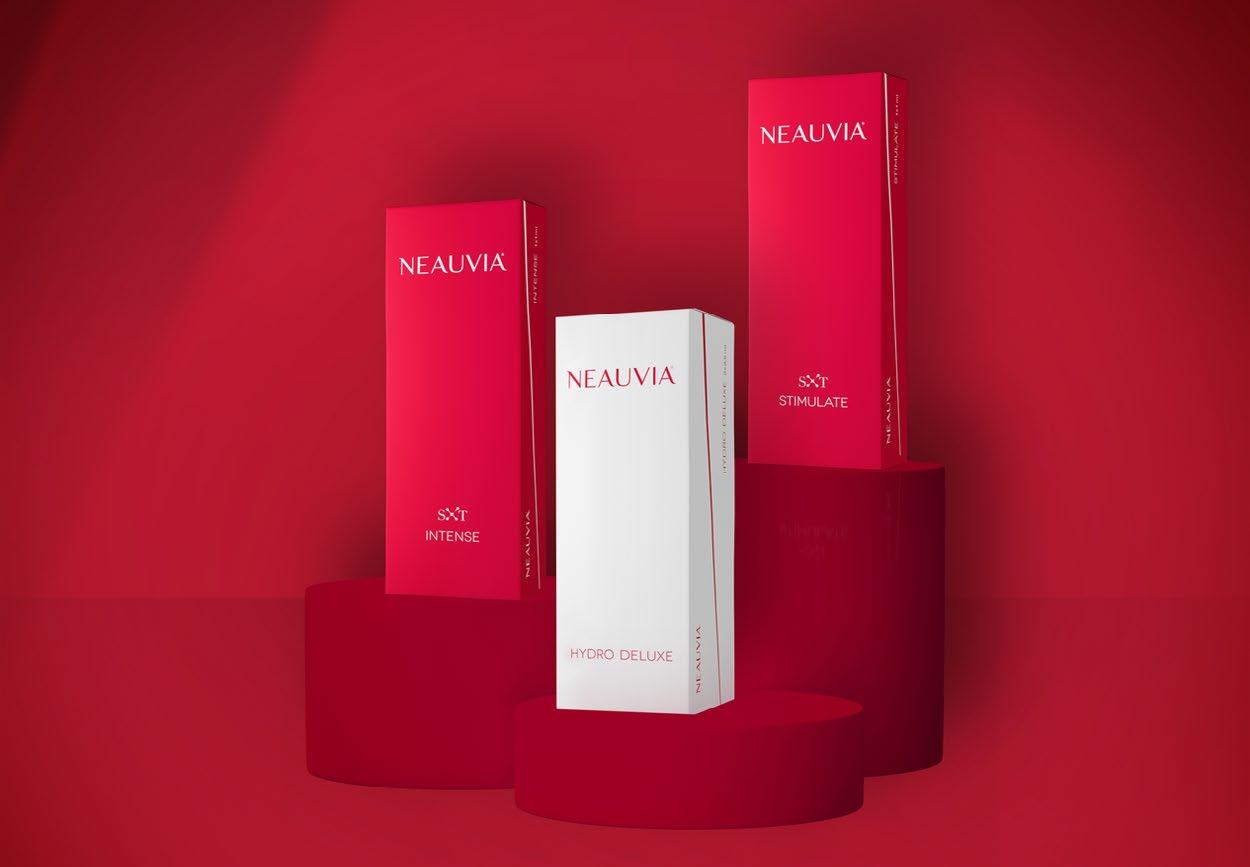
Q u i c k S a f e
E f f e c t i v e
Neauvia PEG-HA Fillers are based on a unique Smart Crosslinking Technology - SXT - combining HA and PEG This gives outstanding mechanical, rheological and thermodynamic properties to the Neauvia’s portfolio, ensuring a high safety profile and tolerability. Thanks to these unique properties, they can be perfectly associated with Neauvia Energy-Based Devices and Neauvia Aesthetic Cosmeceuticals, resulting in improved clinical results through synergistic effects and enhanced aesthetic outcomes.1,2,3,4
neauvia uk | info@neauvia uk | 07570 565715 |



In this section
• Autophagy
• PEG-HA Fillers
• PRP
• Abstracts

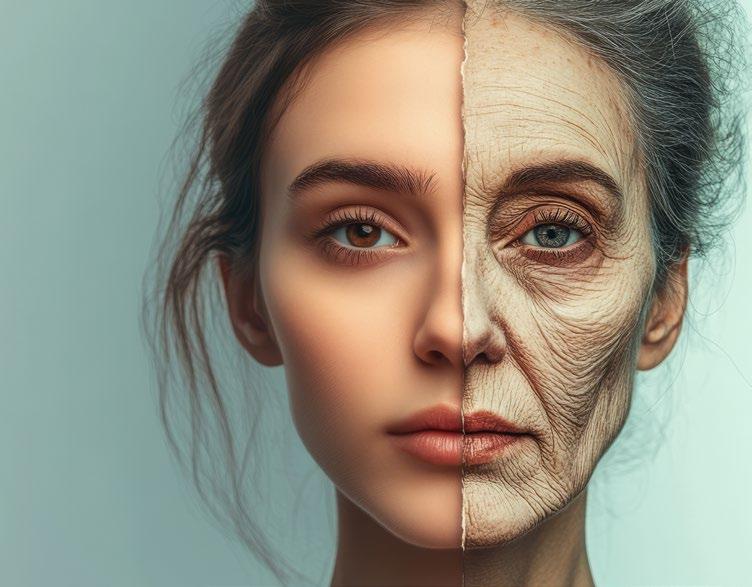

Gary Conroy on why we need to get better at “dying” to achieve healthier, youthful skin
The future of skincare lies in an ageold biological process — autophagy.
Derived from the Greek words for “selfeating,” autophagy is the body’s natural way of clearing out damaged cells and regenerating healthier ones. While this process plays a crucial role in longevity and disease prevention, it is also a revolutionary tool in skin care, offering a pathway to younger, more resilient skin. But here’s the paradox: for autophagy to work, we need to get better at dying — or rather, allowing old, dysfunctional cells to be cleared away, making room for renewal.
Autophagy is the body’s built-in cellular recycling system. It breaks down and

removes defective proteins, damaged organelles, and cellular debris, ensuring that only the healthiest cells survive. This self-cleaning mechanism is essential for maintaining optimal skin function, preventing premature ageing, and supporting overall skin health. By activating autophagy, we enable our skin to repair itself, improve its barrier function, and maintain a youthful glow.
1. Cell renewal – By eliminating damaged cells and replacing them with fresh, new ones, autophagy promotes a vibrant complexion.
2. Reduced inflammation –
Clearing out cellular waste reduces inflammation, benefiting conditions like acne and rosacea.
3. Enhanced repair – Autophagy aids in healing damage caused by UV exposure, pollution, and stress.
4. Improved barrier function – A strong skin barrier retains moisture and defends against external aggressors.
• Vitamin B complex – Supports cell metabolism, enhances hydration, and strengthens the skin barrier. Vitamin B3 (Niacinamide) is a known autophagy activator.
• NAD+ and NMN boosters – Replenish NAD+ levels, ensuring an efficient autophagy process for a more youthful appearance.
• NAMT enzyme – Crucial for NAD+ synthesis, boosting the skin’s ability to sustain autophagy and repair itself.
• Retinoids – Vitamin A derivatives that promote autophagy and accelerate skin renewal.
• Resveratrol – A powerful antioxidant that enhances autophagy and improves overall skin function.
• Green tea extract – Rich in polyphenols that stimulate autophagy while protecting against UV-induced damage.
Beyond topical skincare, lifestyle factors can significantly influence the autophagy process. Adopting the right habits can amplify the skin-rejuvenating benefits:
1. Intermittent fasting – Alternating between periods of eating and fasting activates autophagy and cellular repair.
2. Regular exercise – Physical activity stimulates autophagy in muscle and liver cells, indirectly benefiting skin health.
3. Adequate sleep – Essential for overall cellular maintenance, sleep enhances nighttime autophagy processes, allowing the skin to heal and regenerate.
Autophagy is a fundamental biological process that holds the key to maintaining youthful, resilient skin. By promoting cellular renewal, reducing inflammation, and strengthening the skin barrier, autophagy plays a crucial role in skin longevity. Incorporating autophagy-activating ingredients and lifestyle practices can enhance this process, leading to visible improvements in skin health. In the ever-evolving world of skincare, understanding and harnessing the power of autophagy may be the key to unlocking the most effective anti-ageing strategies. By embracing the natural cycle of cellular renewal, we can achieve skin that is not only healthier but also radiates vitality from within.



Since 2014, 5 Squirrels have helped skincare professionals to launch their own brand skincare products and take back control of their business.
Interested in starting your own brand skincare?
Schedule a call with us now! 01273 734513




Adobe/vidkit/Mane/Matija
We find out about Neauvia’s PEG-HA fillers and why they have such a high safety profile
The world of medical aesthetics is constantly advancing, with dermal fillers playing a key role in non-surgical facial rejuvenation. Among the latest breakthroughs, we can find Neauvia PEGylated hyaluronic acid (PEG-HA) Fillers, which use Smart Crosslinking Technology (SXT) to offer uniqueness, versatility and safety profile.1-2
Neauvia’s monophasic and cohesive hydrogels, enhanced with PEG crosslinking, are rethinking the HA filler market. These fillers provide distinctive characteristics such as mechanical, rheological and thermodynamic properties, ensuring safety profile, versatility and tolerability.3-5
The aim of this study was to assess the effect of PEG-HA + CaHA fillers on both the local tissues and the systemic consequences, which are crucial from a long-term safety perspective in patients suffering from Hashimoto’s disease.
This comprehensive safety study on Neauvia Stimulate demonstrated:
• A significant decrease in the overall local inflammatory infiltrate after PEGylated HA-CaHA injection at day 21 compared to baseline
• No correlation was demonstrated between anti-TPO and antiTG antibodies

• Proven safety among Hashimoto patients was included in the study.
Clinical outcomes of this study, as well as already published data, showed no granulomas, foreign body reactions, or other complications, confirming the clinically high safety profile and the high biocompatibility of PEGylated HA fillers, next to the long-lasting result. There are no substantive or registered contraindications to the use of PEGylated hyaluronic acid fillers in patients with Hashimoto’s.
The immunomodulatory effect of PEG has a positive effect on the safety profile when assessing both the immune effects of the PEG hyaluronic acid filler as well as the stimulatory effect obtained by the calcium hydroxyapatite particles.
A three-year retrospective study aimed to determine the safety and efficacy of PEG-HA fillers retrospectively. The key takeaways include:
• PEGylated ha filler provides a long-lasting effect and better resistance to thermal and mechanical stress, high biocompatibility and safety
• The non-toxicity and non-immunogenicity of PEG provide a lack of allergic and immunological reactions
• No side effects related to immunogenicity were detected, and total absence of oedema.
Clinical outcomes of this article show that in a three-year period, no granulomas, foreign body reactions, or other complications have been reported. These results confirm the clinical outcomes of previous studies published by Zerbinati et al.; PEGylated HA fillers have a high safety profile and a high biocompatibility and result in long-lasting clinical outcomes.
Lip augmentation is a highly sought-after treatment, but achieving natural and balanced results can be challenging. The aim of the study was to evaluate the lip rejuvenation protocol developed by the author in terms of effectiveness, safety and patient satisfaction.
Latin Lips is a hybrid technique dedicated to the lips. The choice of filler for such a dynamic area as the lips is one of the key factors ensuring the success of the procedure. Key messages from this study:
• After the lip injection, the mean scores reported in the study were rated at “very much improved” and “much improved” at 93% (SGAIS) and 91% (PGAIS), as well as subject satisfaction at 93%, indicating significant improvement after the treatment
• Latin Lips technique can be tailor-made and adapted for the patient’s lips and needs without compromising their natural shape, giving volume and contour using a low amount of hyaluronic acid (volumes did not exceed 1.0 ml)
• The dermal filler used showed a high degree of biointegration, with excellent volume and lifting capacity in all subjects, and the investigator reported a very interesting relationship between the amount of product used and the effect achieved.
In this study using the Latin Lips technique, we reported the safety and results of lip beautification using the developed technique by the author and PEGDE-HA filler. The effect obtained was natural and
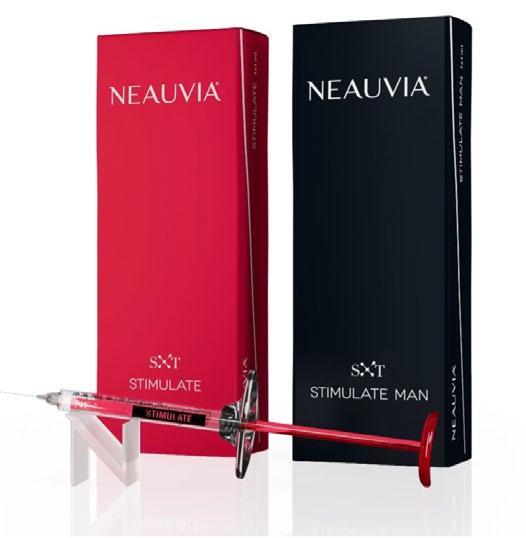
in line with the expectations of the patient and the doctor. The treatment protocol allows satisfactory and reproducible results, which can be achieved with low amounts of filler, which has a beneficial effect on the final aesthetic effect and the patient’s recovery. The technique used, as well as the PEGDE cross-linked product, turned out to be safe and did not cause any adverse events.
1. Marino F, Cosentino M, Legnaro M, Luini A, Sigova J, Mocchi R, Lotti T and Zerbinati N. Immune profile of Hyaluronic Acid hydrogel Polyethylene Glycol crosslinked: an in vitro evaluation in human polymorphonuclear leukocytes. Dermatologic Therapy. 2020; e13388. https://doi.org/10.1111/dth.1338
2. Jeong CH, Kim DH, Yune JH, Kwon HC, Shin DM, Sohn H, Lee KH, Choi B, Kim ES, Kang JH, Kim EK and Han SG. In vitro toxicity assessment of crosslinking agents used in Hyaluronic Acid dermal filler. Toxicology in Vitro, Volume 70, 2021, 105034, ISSN 0887-2333. https://doi.org/10.1016/j.tiv.2020.105034
3. Clinical data on file.
4. Zerbinati N, Lotti T, Monticelli D, Rauso R, González-Isaza P, D’Este E, Calligaro A, Sommatis S, Maccario C, Mocchi R, Lotti J, Wollina U, Tchernev G and França K. In vitro evaluation of the biosafety of Hyaluronic Acid PEG cross-linked with micromolecules of Calcium Hydroxyapatite in low concentration. Open Access Maced J Med Sci. https://doi.org/10.3889/oamjms.2018.044
5. Zerbinati N, Lotti T, Monticelli D, Martina V, Cipolla G, D’Este E, Calligaro A, Mocchi R, Maccario C, Sommatis S, Lotti J, Wollina U, Tchernev G and França K. In vitro evaluation of the sensitivity of a Hyaluronic Acid PEG cross-linked to bovine testes Hyaluronidase. Open Access Maced J Med Sci. https://doi.org/10.3889/ oamjms.2018.046
6. Kubik P, Jankau J, Rauso R, Galadari H, Protasoni M, Gruszczyński W, Grzanka D, Smolińska M, Antosik P, Piesiaków ML, Zerbinati N et al. HA PEGylated filler in association with an infrared energy device for the treatment of facial skin aging: 150 day follow-up data report. Pharmaceuticals 2022, 15, 1355. https://doi.org/10.3390/ ph15111355
7. Kolczewski P, Parafiniuk M, Zawodny P, Haddad R, Nalewczyńska A, Kolasa AK, Wiszniewska B, Menkes S, Bader A, Stabile G and Zerbinati N. Hyaluronic Acid and radiofrequency in patients with urogenital atrophy and vaginal laxity. Pharmaceuticals 2022, 15, 1571. https:// doi.org/10.3390/ph15121571
8.Płatkowska A, Korzekwa S, Łukasik B and Zerbinati N. combined bipolar radiofrequency and non-crosslinked Hyaluronic Acid mesotherapy protocol to improve skin appearance and epidermal barrier function: a pilot study. Pharmaceuticals 2023, 16, 1145. https://doi.org/10.3390/ph16081145

When it comes to platelet-rich plasma (PRP) treatments, results matter, and not all products deliver the same level of efficacy. Cellenis® PRP stands out as a leader in the field, offering a superior formulation and high platelet concentration designed for optimal skin regeneration and rejuvenation with minimal inflammation. With its scientifically advanced, single-spin centrifuge process, Cellenis® PRP isolates the optimal cellular content, ensuring enhanced collagen production, increased skin thickness, and improved elasticity – all with fewer steps and a higher yield.
The key to effective PRP treatment lies in its composition. Cellenis® PRP is engineered to deliver optimal cellular content, enhancing collagen production, improving skin elasticity, and increasing thickness. The result? A more youthful, radiant complexion with minimal downtime.
• The science of simplicity – A streamlined single-spin process ensures maximum platelet recovery with fewer steps.
• High yield, low hassle – Generates more PRP per millilitre while requiring less blood, offering convenience without compromising results.
• Targeted regeneration – A superior concentration of platelets promotes enhanced collagen synthesis and skin rejuvenation.
• No gimmicks, just results –Scientifically proven to support visible, long-term skin transformation with minimal effort.
Your patients deserve more than just PRP — they deserve the best PRP.
Studies show that the PRP obtained has superior characteristics. Some of the platelet properties obtained using the kit have been evaluated in vitro. These characteristics include recovery, aggregation with respect to the activation of collagen (measurement of the aggregation response), response to hypotonic stress (demonstrating the integrity of the platelet membrane),
production of P-selectin (detection on the platelet membrane indicates platelet activation), and increased production of human growth factor secretions (VEGF, EGF, PDGF-BB). Also, the recovery rate of CD34, a marker of the hematopoietic stem cells, has been shown to increase. [Platelet rich plasma (PRP) for Facial Rejuvenation S. ZENKER, Munich, Germany. J. Méd. Esth. et Chir. Derm. Vol. XXXVII, 148, December 2010, 179-183]
Don Buford, MD from Texas Orthobiologics, recently shared their lab test results showing the Cellenis® PRP high platelet count data, and the results were very impressive.
Cellenis® PRP maintained a physiological monocyte level and removed 99.7% of the RBCs, achieving a 4.7x platelet concentration, with a highly effective platelet dose. The results underscore Cellenis® PRP’s unique characteristics: high concentration, low inflammation, and reproducibility with our FDA-cleared kit.
And what’s more, the easy to use, single spin, kits come with everything needed and from blood draw to injection in under 12 mins.
Why stop at regeneration when you can restore lost volume too? Cellenis® DermaFiller provides an exceptional, 100% natural solution that complements PRP therapy by offering both immediate volumisation and long-term tissue regeneration.
Unlike synthetic fillers, Cellenis® DermaFiller is completely autologous, derived from the patient’s own plasma. Its unique formulation encourages the natural production of collagen, fibrin, and elastin, delivering both instant lift and sustained skin revitalisation.
• More than just volume – It’s regeneration – Unlike synthetic
fillers, Cellenis® DermaFiller actively promotes tissue renewal.
• The ultimate natural filler – 100% autologous and bio-stimulating, designed for authentic, long-lasting skin improvement.
• Science-backed, patient-approved – Slow-release growth factors ensure extended and natural-looking results.
• A dual-action powerhouse –Immediate lifting meets deep tissue regeneration for a complete facial transformation.
The ultimate combination: Cellenis® PRP + Cellenis® DermaFiller
Pairing Cellenis® PRP with Cellenis® DermaFiller creates the perfect synergy for aesthetic treatments. Together, they enhance skin quality while restoring lost volume, ensuring long-lasting, natural beauty.
Nurse and PRP expert Claudia McGloin comments, “I’ve been offering PRP treatments for the last 12 years, and have experience of trying a variety of kits. I can honestly say since working with Cellenis, I’ve seen firsthand the remarkable results that Cellenis® PRP and DermaFiller deliver.
“PRP DermaFiller allows me to deliver instant volumisation and hydration, taking my PRP treatments for various clinical indications to a whole new level. My patients love that this is their own body’s filler made from their own growth factors and stem cells. They much prefer this option to synthetic fillers.”.
Not all PRP is equal. Not all fillers are the same. Choose Cellenis® — the gold standard in regenerative aesthetics.
Fore more information please visit: https://amp-uk.co.uk
You can also check out Claudia’s column in Aesthetic Medicine: https:// mag.aestheticmed.co.uk/magazine/ reader/273193?pageNumber=40
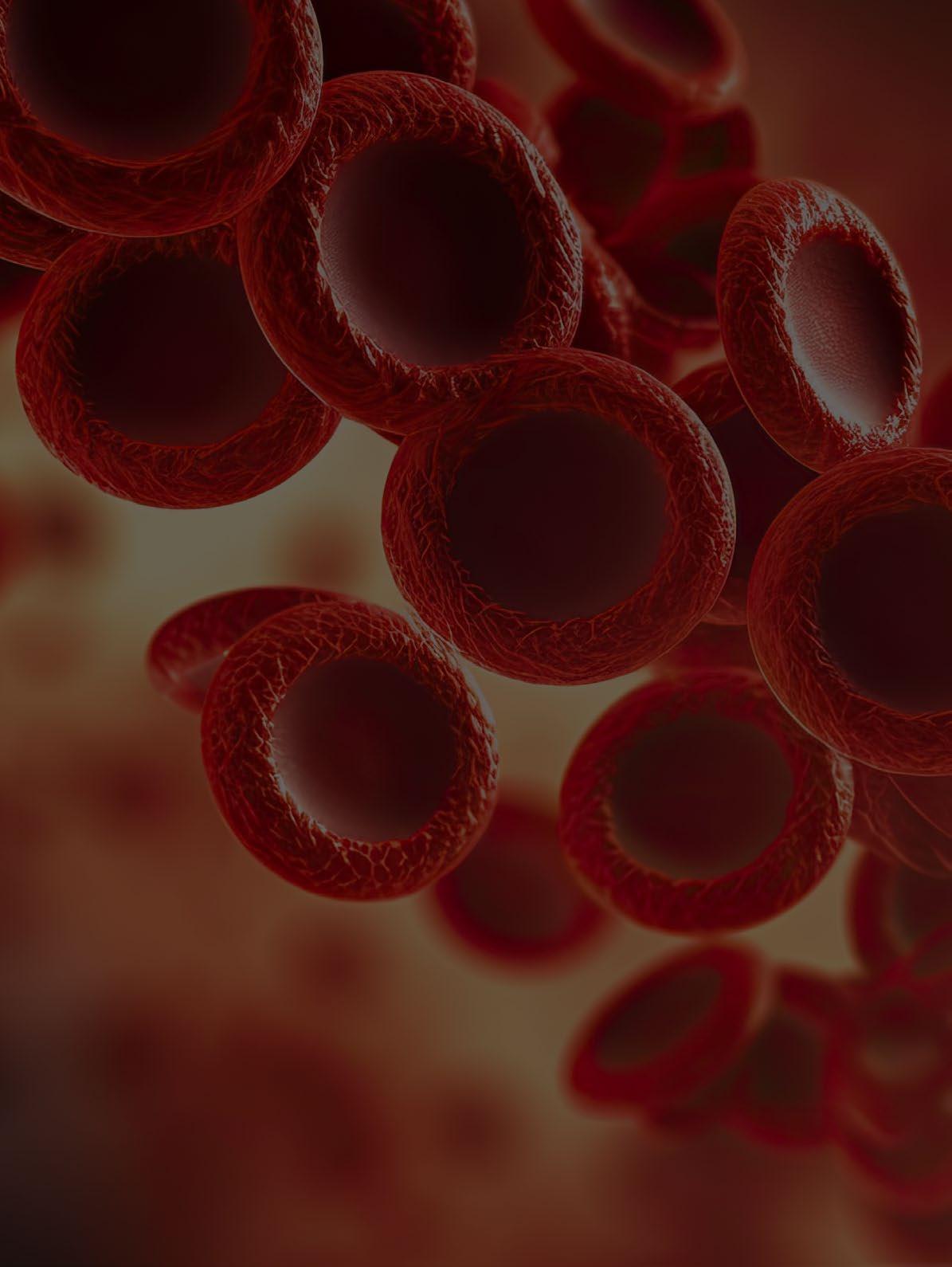


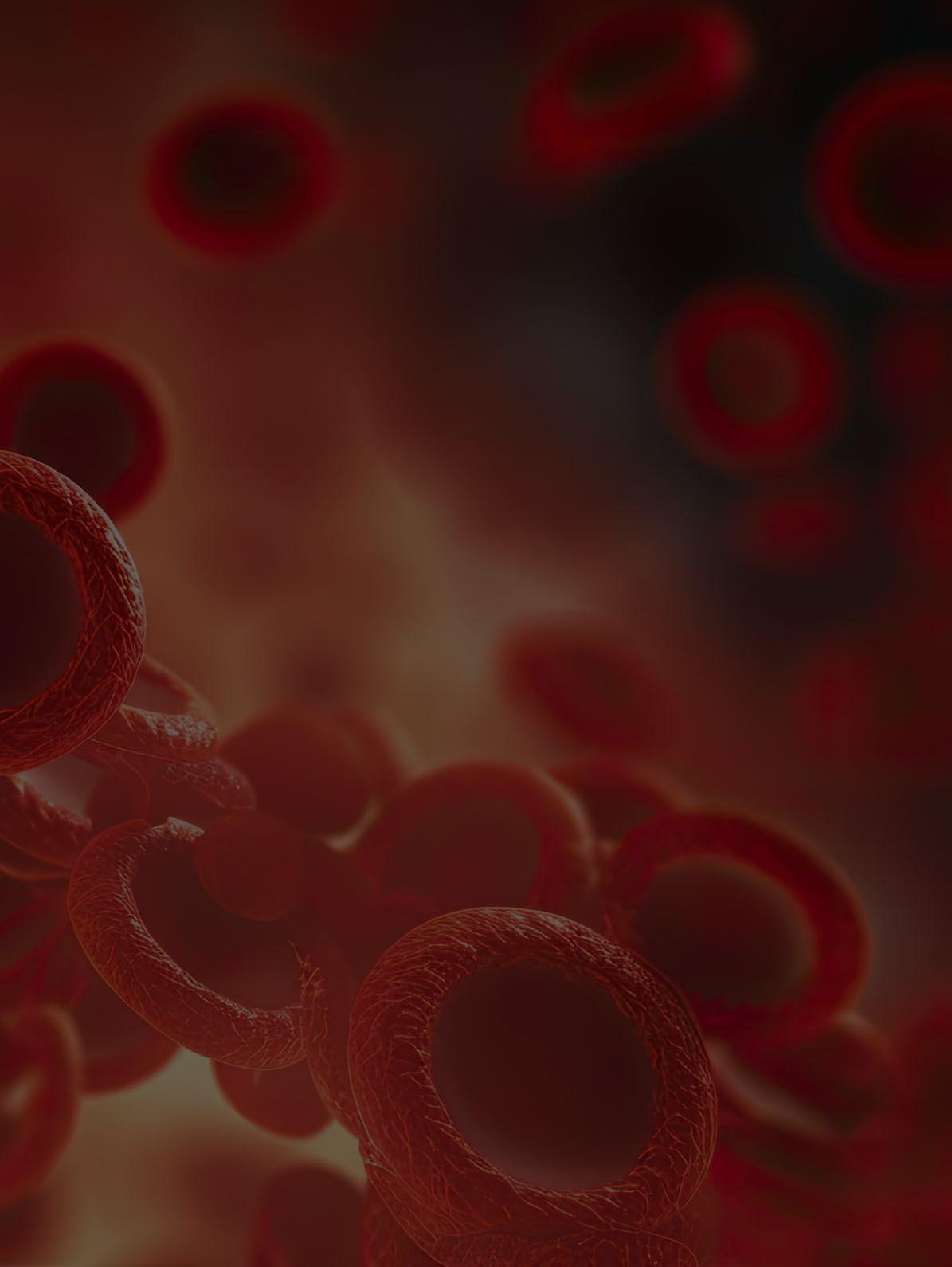
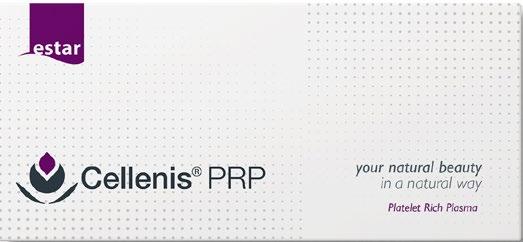

This table shows the ability to concentrate the PRP enabling much higher concentrations of platelets


Adobe/kei907
Aesthetic Surgery Journal, Volume 45, Issue 3, March 2025
Anne F Klassen, DPhil, Charlene Rae, PhD, Andrea L Pusic, MD, Manraj Kaur, PhD
A range of cosmetic treatments to improve skin quality of the décolletage are available. To measure outcomes from the patient perspective, a rigorously developed patient-reported outcome measure (PROM) is needed.
The aim of this study was to develop and validate the BODY-Q Décolletage scale.
Appearance-related codes from BODY-Q concept elicitation interviews were re-examined and 13 items drafted and refined through qualitative interviews with patients and clinicians. The scale was tested in an online international sample of women aged ≥25 years who had previously received a treatment for the décolletage, or in the past 12 months had received a cosmetic treatment at a plastic surgery or dermatology clinic. Data were analysed with both Rasch measurement theory and classical test theory. Construct validity involved testing 20 hypotheses.

Convergent validity tests included correlations between the décolletage scale and other BODY-Q scales and the SKIN-Q.
Interviews conducted with 15 patients and 5 clinicians led to a 16item scale with items that covered scenarios (mirror, photographs, low neckline, lay on side, breasts together, arms crossed, get up, up close), comparisons (with other people), age concerns (youthful, age), qualitative concerns (attractive, healthy), skin tone (evencoloured), and texture (smooth, texture). The field test included 334 participants. An item with poor fit to the Rasch model was dropped. Data for the remaining 15 items fit the Rasch model (χ2 = 76.72, df = 60, P = .07). All items had ordered thresholds and good item fit. All reliability statistics were >0.93. A total of 19 of 20 predefined hypotheses (95%) were met, providing evidence of construct validity.
The BODY-Q Décolletage scale is available to incorporate the perspective of patients into clinical care and clinical trials of minimally invasive treatments to improve skin quality.
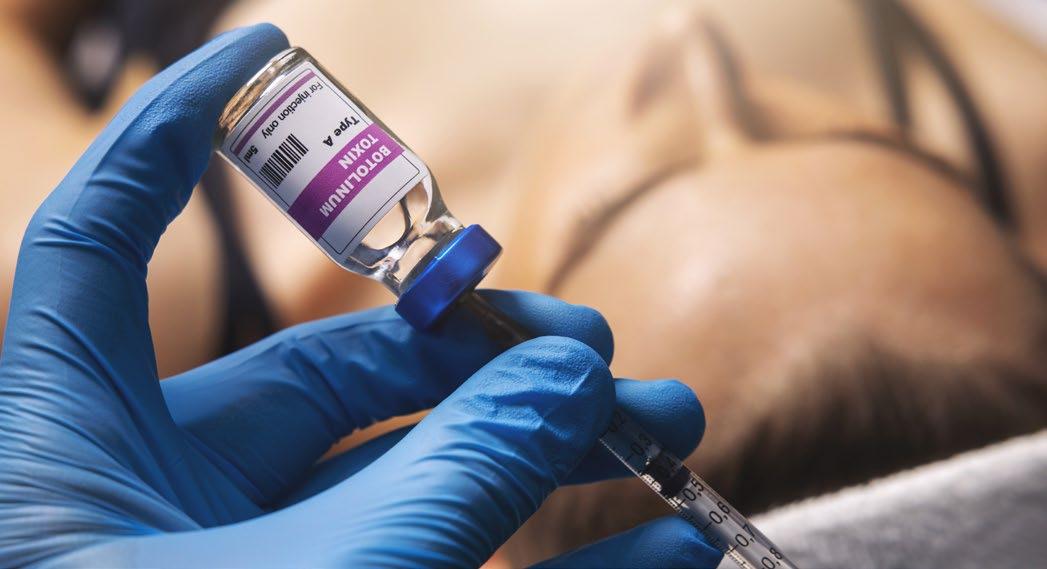
Aesthetic Surgery Journal, January 2025
Zhen Yu Wong, Pegah Damavandi, Maksim Richards, Pojsakorn Danpanichkul, Oluwatobi Adegboye, Ryan Faderani, Muholan Kanapathy, Afshin Mosahebi
Botulinum toxin is widely used in aesthetic medicine, with numerous studies examining its efficacy and safety.
This bibliometric analysis aims to describe research trends and assess the methodological quality of the highest-impact botulinum toxin research in aesthetic applications.
The authors of this study identified the 100 most-cited publications on botulinum toxin in aesthetics using Web of Science, covering all available journal years (from inception to October 2024). The Oxford Centre for Evidence-Based Medicine Level of Evidence (LOE) was used to assess the methodological quality of each study.
The authors identified 1728 articles on the aesthetic uses of botulinum toxin, with the top 100 most-cited articles spanning from 1994 to 2021. The United States dominated the research landscape with 50 articles, followed by Canada (15). The University of California (United States) and the University of British Columbia (Canada) emerged as the top contributing institutions. Among journals, Dermatologic Surgery led in publication count, followed by Plastic and Reconstructive Surgery and Aesthetics Surgery Journal. Notably, Professors Jean Carruthers and Alastair Carruthers from Canada were the leading researchers, topping both publication count and citation metrics. Notably, more than half of the studies were classified as LOE 5 (Expert Opinion/ Narrative Review).
This bibliometric analysis reveals a paucity of high-quality studies in the field of botulinum toxin in aesthetic medicine, with research predominantly concentrated in western countries. These findings highlight the need for more rigorous, evidence-based studies and increased global collaboration to advance the understanding and application of botulinum toxin in aesthetics.





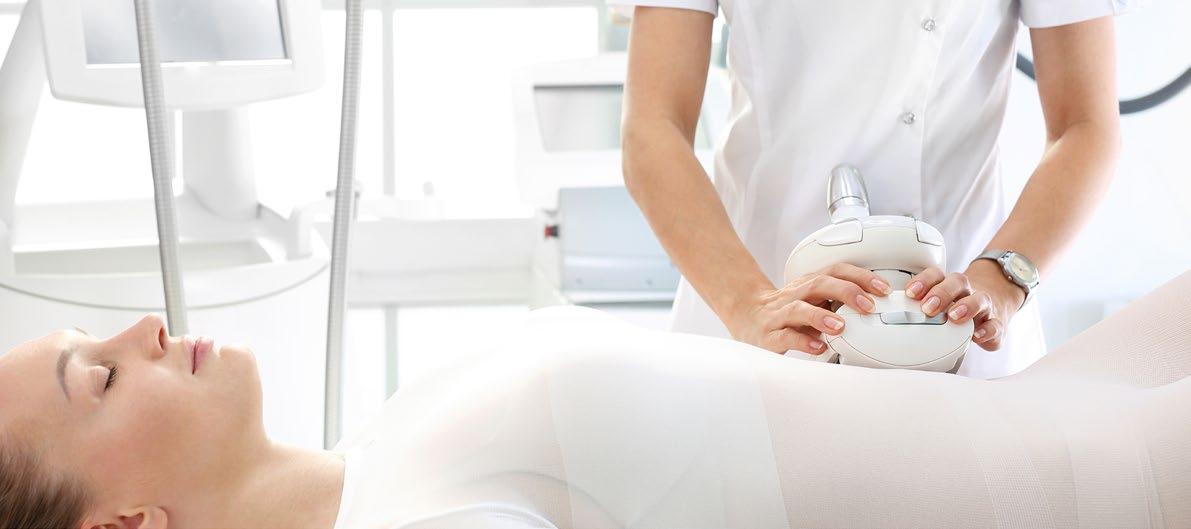
In this section
• LPG • Skin markers • Product News


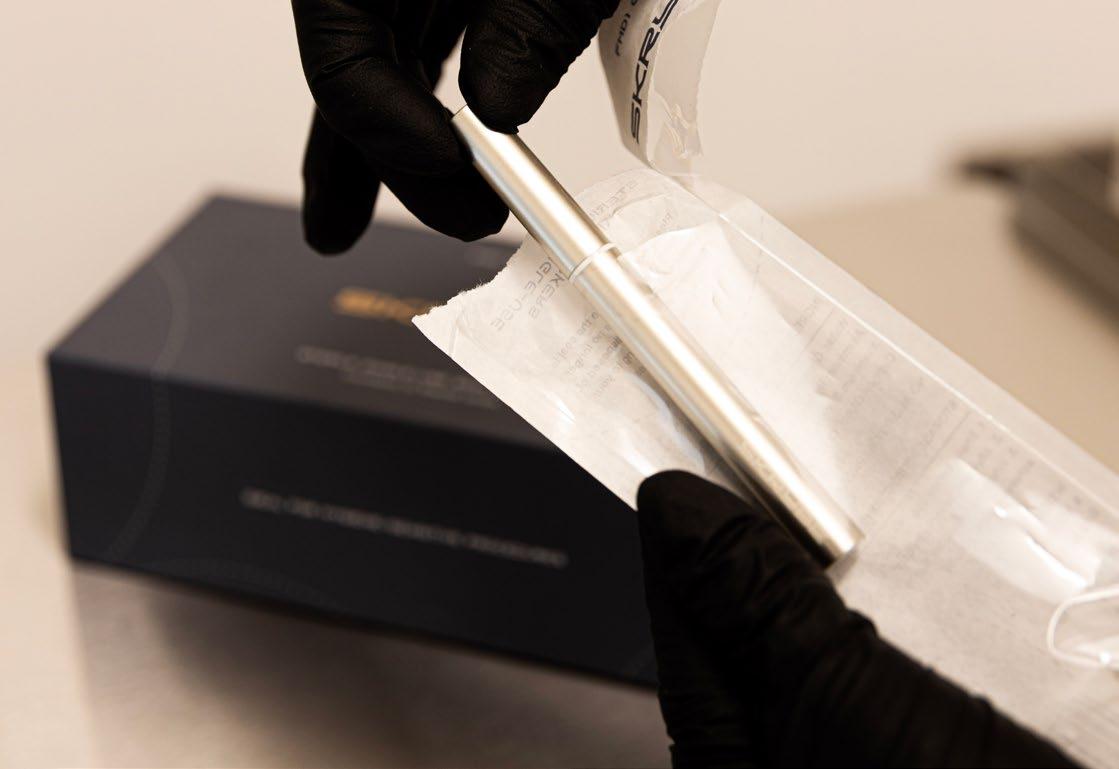
For years, practitioners have relied on makeup pencils, whiteboard markers, and generic alternatives – tools never designed for precision, sterility, or clinical use. Skrybe changes that.
Developed by aesthetic doctors with firsthand experience of traditional marker limitations, the Skrybe markers are specifically for aesthetic and dermatology professionals who demand clarity, reliability, and efficiency in non-invasive treatments and general aesthetic procedures.
FM1.2 is a multi-use skin marker that uses non-toxic white ink for clear and consistent markings. The lightweight, durable design makes it ideal for non-invasive procedures and daily use. FM1.2 provides up to 40 metres of precise markings and can be used multiple times.

FMD1 is a sterile single-use marker that supports aseptic procedures and is built for high-risk and high-turnover settings. Also using non-toxic white ink with the same precision and fine-tip design as FM1.2, the FMD1 delivers markings that are just as sharp and accurate.
The marker is pre-sterilised and individually packaged, ensuring a fresh, uncontaminated tool for each patient. It reduces crosscontamination risks, removing the need for marker disinfection.
Skrybe’s markers have very fine, durable tips with reliable ink flow, enabling you to make intricate and accurate markings on every
patient without interruption. They are waterproof; maintaining markings on the face and body even in the presence of moisture. Markings are easily removed with alcohol wipes. Additionally, their sleek, elegant design reflects the professionalism and modernity of your clinic.
Both FM1.2 and FMD1 are vegan friendly and use allergen-free ingredients. No adverse events have been reported from their use. They are fully recyclable and built to reduce clinic waste – no sharpening or unnecessary excess packaging. The skin markers can be ordered as one-time purchases or on a subscription plan, saving you money and ensuring you’re always in stock.
Both Skrybe markers are loved by the 300+ practitioners who have already used them.
“We love Skrybe. It looks great and, importantly, it’s something the patient actually notices. When you’re a patient, the marker is right in front of you – it’s part of your experience. Skrybe helps us stand out, makes our patients happy, and is simply an improvement over the old-fashioned pencil.” Mr Adrian Richards, consultant plastic surgeon and founder of Cosmetic Courses, Buckinghamshire / Harley Street
• “Super impressed. Best skin marker I have ever used.” Dr Alicia Fernandez, aesthetic practitioner, Hammersmith
• “If you are a nerd about marking pens for injectables, buy these phenomenal pens and thank me later!” Dr Sindhu Siddiqi Pralong, aesthetic practitioner, Kensington
Skrybe was born from a problem only those in the industry truly understood. Founded in the UK by aesthetic doctors, we experienced firsthand the frustration of using outdated, imprecise tools – makeup pencils, generic markers, unreliable substitutes – when precision was everything. The industry had evolved, but the tools hadn’t. So we built what was missing.
Now trusted by leading clinics, educators, and distributors in over 12 countries, Skrybe is shaping the future of aesthetic treatments. Exclusive partnerships, like our collaboration with Wigmore Medical, reinforce our commitment to elevating industry standards. But this is only the beginning. Innovation is at our core, and Skrybe is expanding to deliver even more gamechanging products tailored to the needs of modern aesthetic professionals. This isn’t just a marker – it’s an evolution in precision, trust, and excellence.
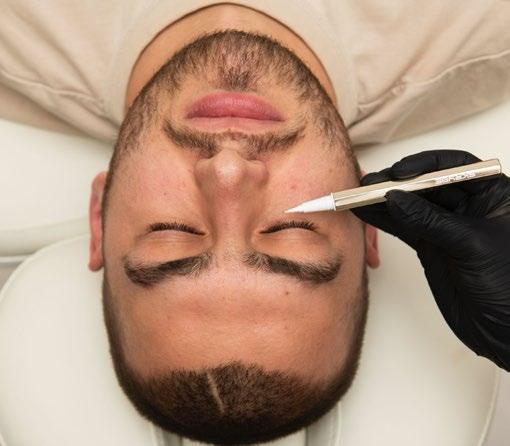
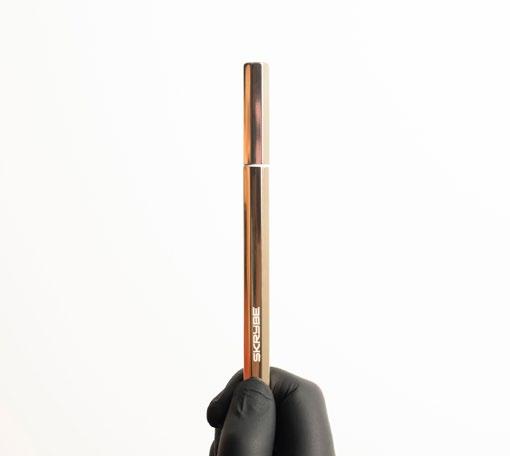
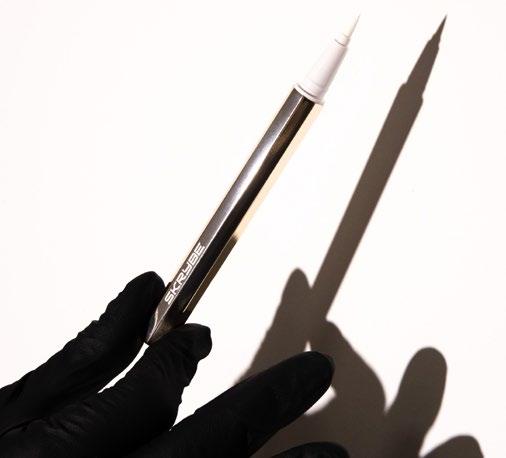

How LPG® endermologie® mechanical stimulation technology can boost vitality, reduce stress, and enhance sleep
Since 1986, the French brand LPG® has been a pioneer in the health, beauty, and well-being industry with its innovative endermologie® technology. This revolutionary mechanical tissue manipulation method mimics the action of a human hand while delivering a deep, pain-free massage that penetrates the body more effectively than traditional manual techniques. By working directly on the lymphatic system, which balances the body’s fluid levels and defends against infection, endermologie® offers significant health benefits beyond its well-known aesthetic advantages.
Long recognised as a French wellness secret, endermologie® is revered for its ability to smooth, slim, firm, and tone the body. However, its impact extends far beyond cosmetic applications. The technology is widely used in the medical industry:
• Physiotherapists in France employ endermologie® to treat muscular conditions.
• Plastic surgeons in the UK integrate it into post-surgery recovery protocols.
• The burns unit at Chelsea & Westminster Hospital, London, utilises it for scar treatment.
In response to modern health concerns such as stress, anxiety, insomnia, and immune function, LPG® has expanded its research to explore the broader benefits of endermologie® on overall wellness.
LPG® conducted a placebo-controlled clinical trial to assess the impact of endermologie® treatments on overall physical, mental, and emotional wellbeing. Participants experiencing high stress and sleep disturbances underwent two 40-minute sessions per week for five weeks using a specialised wellness-focused protocol. The results were groundbreaking.

• Placebo group: 15 participants (2 men, 13 women).
• Experimental group: 14 participants (2 men, 12 women).
Study design: Saliva samples measured cortisol levels before and after the first and last treatments. Psychometric questionnaires assessed anxiety, depression, and perceived stress levels. A wrist-worn actimeter tracked sleep patterns throughout the five-week trial. Blood samples confirmed increased white blood cell production and stronger immune defences.
After 10 sessions of 40-minute endermologie® treatments:
White blood cell count (T-lymphocytes) increased by 9.4%, strengthening immune defences.
• Cortisol levels reduced by 44.6% over five weeks.
• Participants’ perceived stress levels dropped by 49.4%.
• Anxiety and depression scores fell by 50.9%.
• Muscular pain reduced by 69%.
• Heart Rate Variability (HRV), which helps regulate heart rate, blood pressure, breathing, and digestion, increased by 76.6%.
A single session led to a 19% reduction in cortisol levels.
• Insomnia-related disorders reduced by 54.7%.
• Concentration and cognitive performance improved: accuracy increased by 2.5%, and “time on target” by 6%.

• Participants reported enhanced sleep quality, leading to better overall body recovery.
The Vitality, Stress, Sleep endermologie® protocol significantly reduces stress, improves vitality, strengthens immune defenses, alleviates sleep disorders, and enhances overall mood and well-being.
Professor Christophe Hausswirth, the independent clinical research director of the trial, states: “There is already good evidence to suggest that manual massage can reduce cortisol levels and encourage serotonin release. Studies have also shown that manual lymphatic drainage

positively affects the brain and nervous system. This is the first trial to conclusively prove that mechanical massage targeting the lymphatic system can significantly improve multiple aspects of mental and physical health.”
This latest research solidifies LPG®’s role as a leader in holistic wellness. The endermologie® protocol not only addresses modern health concerns but also enhances its core beauty benefits by lowering cortisol levels, enabling the body to release localised resistant fat more effectively.
References
• Cortisol decreases and serotonin/dopamine increase after massage therapyhttps://pubmed.ncbi.nlm.nih.gov/16162447/
• Effects of manual lymph drainage on brain activity in individuals with psychological stress - https://www.ncbi.nlm.nih.gov/pmc/articles/PMC5361017
• Impact of manual lymph drainage on sympathetic nervous system, anxiety, pain, and pressure pain threshold
• Effects of manual lymph drainage on EEG in stress-affected individuals - https:// www.ncbi.nlm.nih.gov/pmc/articles/PMC3927024/

Sculpt Pro Aesthetics has launched the new Follicle Former. Designed to stimulate hair growth from follicles, the device improves scalp health and supports posttransplant healing, as well as promotes natural hair growth.
The low-level laser therapy device is suitable for all hair types, using LLLT to increase blood circulation to the scalp, with adjustable intensity settings for patient comfort.


Vetter has announced the development and upcoming launch of the new version of its proprietary V-OVS syringe closure system. The VOVS-Next will integrate several unique technical advances, like new internal design elements that help prevent accidental spillage when opening the closure, and an updated format that supports correct handling and simplifies opening. For customers with products in glassbarrel syringes, this new closure will be an opportunity to integrate gold-standard Luer Lock features, with the system’s new size being an optimal fit for a broad range of syringes.
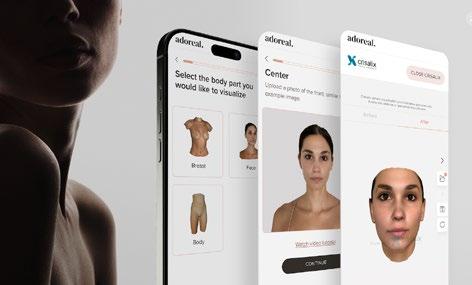

Supramax Pelvic Floor Chair is the latest offering from Pure Tone Aesthetics. The devices are aimed at aesthetic clinics and wellness practices looking to expand their treatment offerings.
The chair utilises high-intensity focused electromagnetic technology, generating electromagnetic pulses that stimulate pelvic floor muscles with precision and intensity. Each 28-minute session delivers the equivalent of 11,000 kegel exercises, providing non-invasive muscle engagement and strengthening.

Adoreal has launched its new 3D visualisation tool to the UK market. Silhouette aims to seamlessly integrate into the patient journey and streamline the consultation process for both face and body by delivering precise, personalised 3D models that help patients truly understand their potential results. This clarity not only fosters more informed decisions but also builds stronger trust between patients and practitioners. Silhouette enables prospective patients to visualise potential aesthetic outcomes with unparalleled accuracy, removing any guesswork from surgical outcomes, fostering greater communication and trust between clinics and patients, and ensuring informed decision-making and enhanced satisfaction.

Harness the unmatched synergy of Cellenis® PRP and Cellenis® DermaFiller. Together, they offer a comprehensive approach to skin rejuvenation and volume restoration - delivering natural, long-lasting results that set your practice apart.
Discover the Cellenis® Advantage Today!
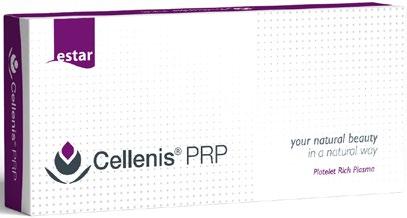

Cellenis® PRP takes the complexity out of platelet-rich plasma preparation with its innovative gel-based separation technology.
By isolating the ideal platelet and cellular content, Cellenis® PRP delivers superior results:
• Brightens and enhances dermal collagen.
• Rejuvenates skin and slows the aging process by boosting fibroblast activity, encouraging stem cell growth, and promoting new collagen and blood vessel formation.
• Stimulates oil glands to combat dryness and restores skin’s natural glow.
• Increases blood supply to the skin, fostering healthier, younger-looking skin.
• High platelet recovery and minimal red/inflammatory white blood cells.
• Fewer steps and a single centrifuge spin for ease of use.
• High PRP yield: 6ml from an 11ml tube and 13ml from a 22ml tube.
• Versatile, non-allergenic, with virtually no downtime.
• With Cellenis® PRP, your patients achieve radiant skin that feels refreshed and rejuvenated - naturally.
Cellenis® DermaFiller is a 100% natural injectable material that combines the immediate volumising effect of a filler with the tissue regeneration benefits of PRP. Its groundbreaking technology delivers extended release of platelet-derived growth factors to:
• Induce new collagen formation for added lift and firmness.
• Improve skin texture and elasticity with fibrin and elastin stimulation.
• Rejuvenate both face and body for comprehensive aesthetic solutions.
Cellenis® DermaFiller uses uniquely heated platelet-poor plasma (PPP) to restructure proteins, offering extended resorption properties lasting 3–6 months. This creates a protein scaffold that naturally adds volume, while bio-stimulating tissue regeneration for radiant, youthful skin.

• Effective for both face and body treatments.
• Derived from autologous materials for unmatched safety and compatibility.
• Decelerates aging by replacing lost volume and preventing further tissue loss.
• Provides 13ml of regenerative material from a 22ml kit or 6ml from an 11ml kit, ensuring flexibility for both comprehensive and targeted treatments.
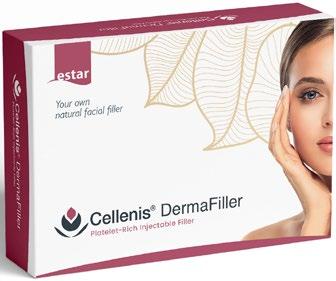


In this section
• CPD: Skin of colour
• Tixel
• Product News

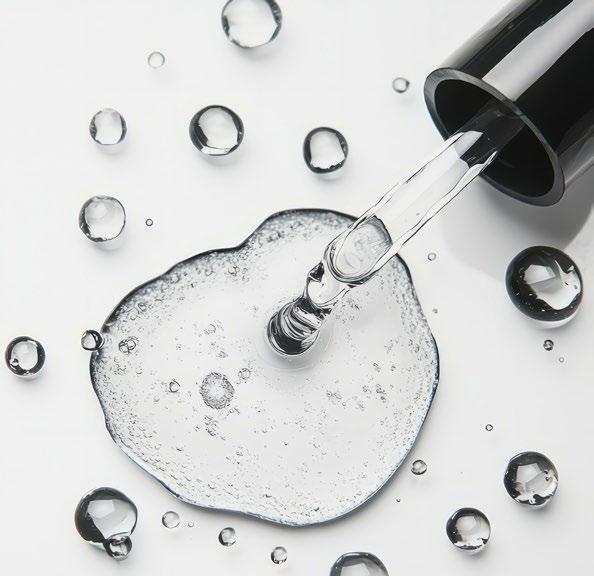
The aesthetics industry has evolved significantly in recent years, embracing inclusivity and acknowledging the unique needs of individuals with different skin tones.1 However, despite some advances, aesthetic medicine training and clinical trials have remained largely centred around Caucasian skin, leaving significant gaps in knowledge and clinical training when it comes to treating patients with skin of colour.2-6 In addition, treatments and products have been developed with a narrow focus, often overlooking the unique needs of patients with skin of colour. This limitation can result in misdiagnoses, ineffective treatments, and an overall lack of trust in aesthetic practitioners.3,7
The need for aesthetic professionals to broaden their understanding and expertise in treating patients with darker skin tones has never been greater.8 It is essential that practitioners recognise the structural and functional differences in skin of colour and adapt their treatments accordingly.9 Without proper knowledge, there is an increased risk of adverse effects, particularly hyperpigmentation and scarring, which are more prevalent in these patient groups.10 Furthermore, cultural competence is equally critical – understanding beauty ideals, patient concerns, and historical experiences with the medical field can strengthen the practitioner-patient relationship and enhance treatment outcomes.7,11-13
Physiological considerations in skin of colour
Understanding the physiological characteristics of skin of colour is key to delivering safe and effective aesthetic treatments.7 One of the most important factors to consider is the increased activity of melanocytes, which are responsible for pigment production.14-15
Black skin has more melanin than white skin.7 In fact, some studies have shown that black skin produces twice as much melanin as white skin and they are more evenly distributed with the epidermis.7,16 While this provides some natural protection against UV damage, it also
makes individuals with darker skin more susceptible to post-inflammatory hyperpigmentation (PIH).17-18 Any form of trauma, including aggressive exfoliation, chemical peels, or laser treatments, can lead to excessive melanin production, resulting in persistent dark marks.10
Additionally, wound healing in skin of colour presents distinct challenges.4 The heightened response of fibroblasts can lead to excessive collagen production, increasing the likelihood of keloid and hypertrophic scarring.19-21 Treatments such as dermal fillers, microneedling, or laser resurfacing must be carefully adjusted in line with each patient’s individual needs to minimise unnecessary inflammation.6-7 In some cases, alternative treatment strategies may be required to avoid triggering unwanted skin reactions.
Another consideration is the structure of the dermal-epidermal junction, which differs slightly in darker skin tones.17,22 In addition, there may be increased skin sensitivity and a higher likelihood of irritation from active ingredients found in some skincare products or active ingredients. For example, retinoids and high-potency exfoliants may cause greater irritation in darker skin than in lighter complexions.23 Consequently, treatment protocols should prioritise skin barrier protection and hydration to maintain optimal skin health and prevent adverse reactions.
Another significant distinction between highly pigmented and lighter skin is the rate of trans-epidermal water loss (TEWL).7 The skin’s primary role is to act as a barrier, preventing excessive water evaporation through the outermost layer, the stratum corneum. Research indicates that while melanin-rich skin tends to have a higher sebum production and a denser stratum corneum7 – comprising around twenty layers of cells compared to approximately sixteen in lighter skin – it also has lower ceramide levels. This reduction in ceramides contributes to increased moisture loss, making individuals with more pigmented skin more susceptible to xerosis, particularly in colder climates. As a
result, conditions such as dry, flaky, or ashy skin are more commonly observed in these populations.7
Many skin conditions present differently in patients with skin of colour, making accurate diagnosis and effective treatment more challenging for practitioners who are not familiar with these variations.7,24-26 For instance, eczema does not always exhibit the typical redness seen in Caucasian skin but instead may appear as brown, purple, or grey patches.27 Similarly, psoriasis often presents as dark brown or violaceous plaques rather than the classic erythematous appearance.28 The risk of misdiagnosis is significant, as these conditions may be mistaken for postinflammatory hyperpigmentation or other disorders.
Acne is another common concern among patients with darker skin, often complicated by the presence of hyperpigmentation.7,29 Unlike Caucasian patients, where the primary concern may be inflammation and active lesions, individuals with skin of colour frequently experience residual dark spots that persist long after the acne has resolved. This means that a comprehensive treatment plan should address both acne control and pigment correction, incorporating products and procedures that reduce inflammation while minimising the risk of PIH.
Hyperpigmentation disorders such as melasma and vitiligo can also be more pronounced in darker skin tones and can have significant psychological and social impacts. Treatments for these conditions require a cautious approach, as aggressive interventions can worsen pigmentation irregularities. Laser therapy, for instance, must be carefully selected to avoid exacerbating pigmentation issues, while chemical peels should be performed with gentler acids that do not trigger an inflammatory response.


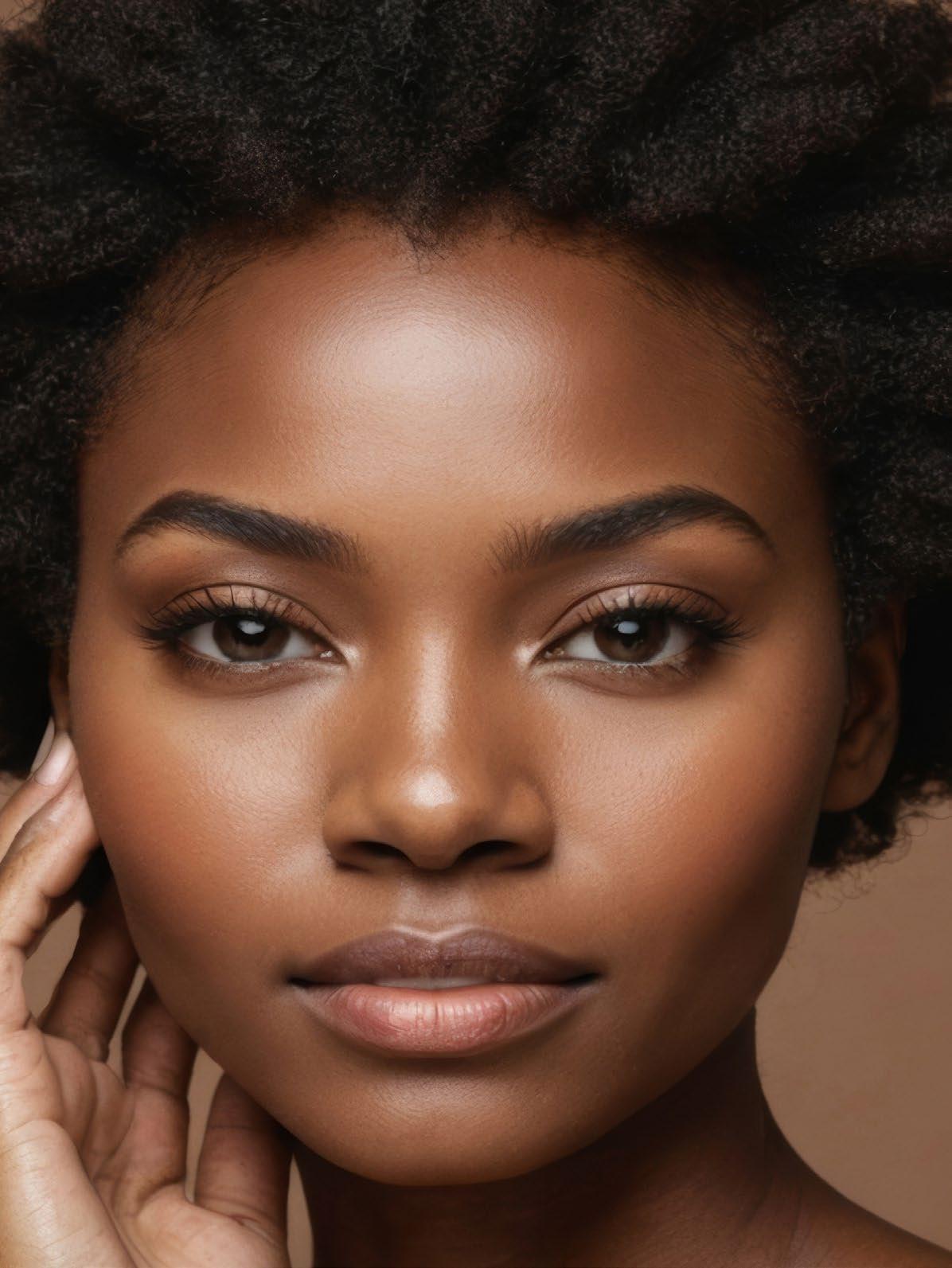

While many aesthetic procedures can be safely performed on patients with darker skin types, modifications are often necessary to reduce the risk of adverse effects.30 Chemical peels, for example, should be chosen with caution, avoiding highly aggressive exfoliants such as phenol or high-strength glycolic acid, which may cause excessive irritation. Instead, practitioners can opt for milder alternatives like mandelic or lactic acid, which provide exfoliation without inducing inflammation.31
Laser treatments require particular attention, as inappropriate settings can lead to burns, hyperpigmentation, or hypopigmentation.32 Proper cooling techniques and cautious energy settings are essential when performing laser hair removal or resurfacing treatments on patients with skin of colour.33
Injectable treatments, including dermal fillers and neurotoxins, must also be administered with care.5-6 While these procedures are generally safe, practitioners should be mindful of vascular differences in darker skin and use conservative techniques to prevent complications such as vascular occlusion. Ensuring that patients are well-informed about potential side effects and expected outcomes is an important aspect of treatment planning.
One of the most common misconceptions about skin of colour is that it does not require sun protection.7,15,34 While melanin provides some degree of natural sun defence, it does not eliminate the risk of photodamage, premature ageing, or skin cancer. Unfortunately, due to a lack of targeted education and marketing, many individuals with darker skin tones do not use sunscreen regularly. Studies have shown that skin cancer in Black patients is often diagnosed at a more advanced stage, leading to poorer outcomes. Therefore, it is crucial for aesthetic practitioners to educate their patients on the importance of daily sun protection and recommend broad-spectrum sunscreens suitable for darker skin.

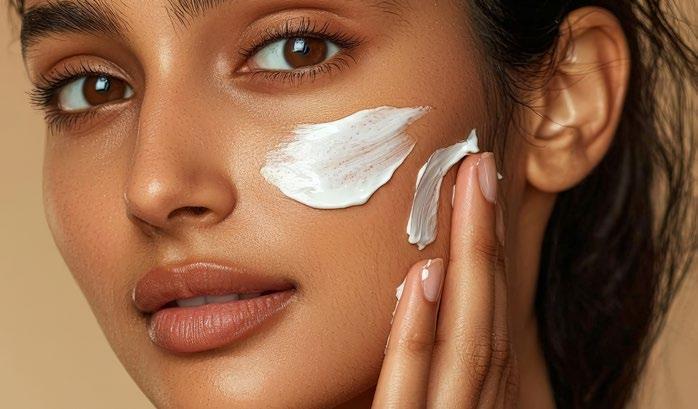
Beyond clinical knowledge, cultural competence plays a vital role in aesthetic medicine. Understanding the beauty standards, preferences, and concerns of diverse patient populations fosters a more inclusive and supportive environment. Patients should feel comfortable discussing their aesthetic goals without fear of being dismissed or misunderstood. This requires practitioners to actively educate themselves on the unique experiences of individuals with skin of colour, as well as the historical context that has shaped their relationship with the beauty and medical industries.
Inclusivity should also extend to marketing and branding efforts. Clinics that feature diverse models in promotional materials, showcase a variety of treatment results, and engage with diverse audiences on social media can help build trust and accessibility. Additionally, practitioners who lack direct experience treating skin of colour should establish referral networks with experts who do, ensuring that all patients receive the highest standard of care.
Providing safe and effective aesthetic treatments for patients with skin of colour requires a commitment to education, adaptability, and inclusivity. By understanding the physiological
differences, recognising variations in skin condition presentations, and modifying treatment protocols accordingly, practitioners can improve patient outcomes and foster trust. Cultural competence is equally critical in ensuring that all patients feel seen, valued, and confident in the care they receive. Continuous professional development, including attending conferences and engaging with resources such as The Black Skin Directory and Skin of Colour Training UK, can help practitioners stay informed and improve their expertise in this vital area of aesthetic medicine.



References
1. https://mag.aestheticmed.co.uk/articles/240240?article=54-1
2. https://aestheticmed.co.uk/new-research-emphasises-gap-in-skincare-equity
3. Alexis AF, Few J, Callender VD, Grimes P, Downie J, Boyd C, Gallagher CJ. Myths and Knowledge Gaps in the Aesthetic Treatment of Patients With Skin of Color. J Drugs Dermatol. 2019 Jul 1;18(7):616-622. PMID: 31329382.
4. Johnson J, Johnson AR Jr, Andersen CA, Kelso MR, Oropallo AR, Serena TE. Skin Pigmentation Impacts the Clinical Diagnosis of Wound Infection: Imaging of Bacterial Burden to Overcome Diagnostic Limitations. J Racial Ethn Health Disparities. 2024 Apr;11(2):1045-1055. doi: 10.1007/s40615-023-01584-8. Epub 2023 Apr 11. PMID: 37039975; PMCID: PMC10933203.
5. https://www.harleyacademy.com/aesthetic-medicine-articles/complications-from-injectables-and-darker-skin/
6. https://www.harleyacademy.com/aesthetic-medicine-articles/why-every-injector-needs-to-understand-black-skin/
7. https://www.aestheticnursing.co.uk/content/clinical/understanding-the-needs-of-skin-of-colour/ 8. https://www.consultingroom.com/industry/blog/inclusivity-for-skin-of-colour
9. Iwuala C, Taylor SC. Structural and functional differences in skin of colour. Clin Exp Dermatol. 2022 Feb;47(2):247-250. doi: 10.1111/ ced.1489. Epub 2021 Oct 19. PMID: 34388277.
10. Lawrence E, Syed HA, Al Aboud KM. Postinflammatory Hyperpigmentation. [Updated 2024 Nov 25]. In: StatPearls [Internet]. Treasure Island (FL): StatPearls Publishing; 2025 Jan-. Available from: https://www.ncbi.nlm.nih.gov/books/NBK559150/
11. Saha S, Beach MC, Cooper LA. Patient centeredness, cultural competence and healthcare quality. J Natl Med Assoc. 2008 Nov;100(11):127585. doi: 10.1016/s0027-9684(15)31505-4. PMID: 19024223; PMCID: PMC2824588.
12. Villanueva-Tobaldo, Carlota, Jose Francisco Tornero-Aguilera, Alejandro Rubio-Zarapuz, y Vicente Javier Clemente-Suarez. «Cultural influences on Aesthetic Medicine choices: the role of psychology». Aesthetic Medicine. Salus Internazionale ECM Srl, 2024. https://doi. org/10.57662/AM.V10I4.15534.
13. https://www.dermatologytimes.com/view/tailoring-aesthetic-treatments-for-patients-with-skin-of-color
14. Thawabteh AM, Jibreen A, Karaman D, Thawabteh A, Karaman R. Skin Pigmentation Types, Causes and Treatment-A Review. Molecules. 2023 Jun 18;28(12):4839. doi: 10.3390/molecules28124839. PMID: 37375394; PMCID: PMC10304091.
15. https://www.blackskindirectory.com
16. Vashi NA, De Castro Maymone MB, Kundu RV. Aging differences in ethnic skin. J Clin Aesthet Dermatol. 2016; 9:(1)31-38
17. Markiewicz E, Karaman-Jurukovska N, Mammone T, Idowu OC. Post-Inflammatory Hyperpigmentation in Dark Skin: Molecular Mechanism and Skincare Implications. Clin Cosmet Investig Dermatol. 2022 Nov 25;15:2555-2565. doi: 10.2147/CCID.S385162. PMID: 36466945; PMCID: PMC9709857.
18. https://mag.aestheticmed.co.uk/articles/257260?article=32-1#:~:text=Post%2Dinflammatory%20hyperpigmentation%20(PIH),ready%20 for%20the%20activation%20stage.
19. Muthusubramaniam L, Zaitseva T, Paukshto M, Martin G, Desai T. Effect of collagen nanotopography on keloid fibroblast proliferation and matrix synthesis: implications for dermal wound healing. Tissue Eng Part A. 2014 Oct;20(19-20):2728-36. doi: 10.1089/ten.TEA.2013.0539. Ep
20. Chike-Obi CJ, Cole PD, Brissett AE. Keloids: pathogenesis, clinical features, and management. Semin Plast Surg. 2009 Aug;23(3):178-84. doi: 10.1055/s-0029-1224797. PMID: 20676312; PMCID: PMC2884925.ub 2014 May 20. PMID: 24724556; PMCID: PMC4195479.
21. https://www.medicalnewstoday.com/articles/keloids-on-black-skin
22. Salminen AT, Manga P, Camacho L. Race, pigmentation, and the human skin barrier-considerations for dermal absorption studies. Front Toxicol. 2023 Oct 11;5:1271833. doi: 10.3389/ftox.2023.1271833. PMID: 37886124; PMCID: PMC10598584.
23. https://www.aad.org/public/everyday-care/skin-care-secrets/anti-aging/retinoid-retinol#:~:text=%22With%20skin%20of%20color%2C%20 irritation%20can%20trigger,using%20moisturizer%20will%20help%20mitigate%20this%20possibility.%22
24. https://pharmaceutical-journal.com/article/ld/recognising-common-skin-conditions-in-people-of-colour
25. https://www.ajmc.com/view/darker-skin-means-different-presentations-of-skin-diseases-explains-dr-james-song
26. https://pharmaceutical-journal.com/article/ld/recognising-common-skin-conditions-in-people-of-colour?utm_source=chatgpt.com
27. https://nationaleczema.org/blog/eczema-in-skin-of-color/#:~:text=Most%20people%20think%20of%20eczema,or%20ashen%20grey%20 in%20color.
28. Alexis AF, Blackcloud P. Psoriasis in skin of color: epidemiology, genetics, clinical presentation, and treatment nuances. J Clin Aesthet Dermatol. 2014 Nov;7(11):16-24. PMID: 25489378; PMCID: PMC4255694.
29. https://www.health.harvard.edu/blog/acne-considerations-for-darker-skin-2021030322038#:~:text=Acne%20triggers%20release%20of%20 melanin&text=This%20can%20result%20in%20dark,in%20people%20with%20darker%20skin.
30. Desai M, Gill J, Luke J. Cosmetic Procedures in Patients with Skin of Color: Clinical Pearls and Pitfalls. J Clin Aesthet Dermatol. 2023 Mar;16(3):37-40. PMID: 36950048; PMCID: PMC10027327.
31. Vemula S, Maymone MBC, Secemsky EA, Widjajahakim R, Patzelt NM, Saade D, Vashi NA. Assessing the safety of superficial chemical peels in darker skin: A retrospective study. J Am Acad Dermatol. 2018 Sep;79(3):508-513.e2. doi: 10.1016/j.jaad.2018.02.064. Epub 2018 Mar 5. PMID: 29518457.
32. Harnchoowong S, Vachiramon V, Jurairattanaporn N. Cosmetic Considerations in Dark-Skinned Patients. Clin Cosmet Investig Dermatol. 2024 Feb 1;17:259-277. doi: 10.2147/CCID.S450081. PMID: 38321987; PMCID: PMC10844008.
33. Cole PD, Hatef DA, Kaufman Y, Pozner JN. Laser therapy in ethnic populations. Semin Plast Surg. 2009 Aug;23(3):173-7. doi: 10.1055/s-00291224796. PMID: 20676311; PMCID: PMC2884928.
34. https://www.soctuk.org/sunscreen-in-skin-of-colour


The latest breakthrough in skin rejuvenation doesn’t involve lasers, needles, or lengthy recovery times. Tixel 2, recently FDA-cleared for treating wrinkles and skin resurfacing, is garnering attention from top dermatologists for its unique approach to skin renewal.
Unlike traditional treatments that use light energy or needles, Tixel 2 employs precisely controlled heat through microscopic titanium pyramids that briefly contact the skin.
“It’s completely revolutionising how we approach skin rejuvenation,” says Dr Ofir Artzi, head of the Center for Aesthetic Dermatology at Tel Aviv Medical Center. “We’re seeing impressive results without the downtime typically associated with more aggressive treatments.”

The technology, called Thermo-Mechanical Action, works by creating thousands of microscopic treatment zones in the skin. These tiny channels stimulate the body’s natural healing response, promoting collagen production and skin renewal. What makes it unique is the gentle pressing motion - no cutting or piercing involved.
“What’s particularly exciting is that we can treat areas that were traditionally challenging, like directly around the eyes,” notes Dr Morris Hartstein, who has extensively studied the technology. “And because there’s no light energy involved, we don’t need protective eyewear or special safety protocols.”
Clinical studies reveal why this approach works:
• Brief heat exposure triggers
collagen production: The hightemperature pulses from Tixel stimulate fibroblasts, the cells responsible for producing collagen and elastin. This enhances skin elasticity, reducing fine lines and wrinkles over time.
• Microchannels enhance product absorption: The small treatment zones created by Tixel temporarily increase skin permeability. This allows serums, growth factors, and active skincare ingredients to penetrate more deeply, maximising their efficacy.
• Controlled thermal zones promote skin remodelling: Unlike lasers that rely on aggressive ablation, Tixel’s controlled heat prompts a natural regenerative process. This means more even skin tone, improved texture, and a reduction in pigmentation.
• Natural healing response improves texture: The body’s innate repair mechanisms are triggered, accelerating cellular turnover and skin renewal. Patients notice progressive improvements in the weeks and months following treatment.
• Progressive results continue for months: Unlike more aggressive treatments that yield an immediate but short-lived effect, Tixel treatments continue to show visible benefits for months, as the stimulated collagen production enhances skin structure over time.
Beyond the science, practical advantages are driving adoption among dermatologists and patients alike. The treatment is particularly effective for particularly effective for fine lines and wrinkles, uneven skin texture, acne scarring, under-eye concerns and neck and chest rejuvenation. In addition, benefits include:
• No anaesthesia required: Unlike many laser treatments that necessitate numbing creams or local anaesthetics due to high levels of discomfort, Tixel treatments are relatively painless. Patients often report only a mild warming sensation, making the procedure quick and convenient.
• Safe for all skin types: Tixel’s nonlight-based heat mechanism makes it suitable for all skin types.
• Year-round treatment possible: Many laser procedures require patients to avoid sun exposure before and after treatment due to the risk of post-inflammatory hyperpigmentation. Tixel’s controlled thermal energy is less aggressive, allowing it to be performed safely throughout the year without seasonal restrictions.
• Minimal recovery time: Downtime is a significant concern for many patients, particularly those with busy schedules. Tixel treatments typically involve mild redness and slight swelling for just 24 to 48 hours, compared to the weeks of recovery associated with some laser treatments. Many patients can resume normal activities immediately.
• Comfortable procedure: With Tixel, the absence of harsh ablation means a significantly more comfortable experience. The brief thermal contact ensures effective results with minimal discomfort, making it a preferred option for those seeking rejuvenation
without the pain associated with traditional lasers.
Most patients describe the sensation as warm but comfortable, similar to a hot stone massage. Treatment typically takes 15-20 minutes, with many returning to their normal activities the same day. Some experience mild redness for a few hours, but it’s notably less than with laser treatments.
“My patients are particularly impressed by how comfortable the treatment is,” says Dr Artzi. “Many are surprised they don’t need numbing cream, even for sensitive areas like around the mouth.”
Most patients undergo three to four treatments spaced about a month apart. Results develop gradually, with optimal improvement visible about three months after the final session. Many doctors are combining Tixel 2 with other treatments for enhanced results.
If you’re looking for significant skin improvement without aggressive treatment or extended downtime, Tixel 2 might be your answer. “It fills an important gap in our treatment options,” says Dr Hartstein. “We can now offer patients meaningful results without the recovery time of more intensive procedures.”
For more information please visit: www.smartgroup-medical.co.uk/tixel


Smart Group Medical is proud to announce its exclusive partnership with AQ Skin Solutions, becoming the UK distributor of the awardwinning growth factor global skincare range. This landmark collaboration marks a significant milestone in Smart Group Medical’s commitment to bringing clinically proven, high-performance aesthetic solutions to practitioners and clinics nationwide.
Developed by esteemed biomedical scientist Dr Ahmed Al-Qahtani, AQ Skin Solutions is at the forefront of regenerative aesthetics, combining advanced science with clinically proven formulations.
Dr Al-Qahtani said,“We are excited to be working with The Smart Group to bring a new phase of customer service and innovation to the UK market. AQ continues to lead the UK market in the regenerative space, and with this new partnership with The Smart Group, we are confident in elevating the customer experience with our new products and services.”
The official UK launch will take place at Aesthetic Medicine Live on May 9-10, 2025 at Olympia London, where Dr Al-Qahtani will take the stage to share his expertise on the science behind Growth Factor technology and its transformative impact on skincare and hair restoration.


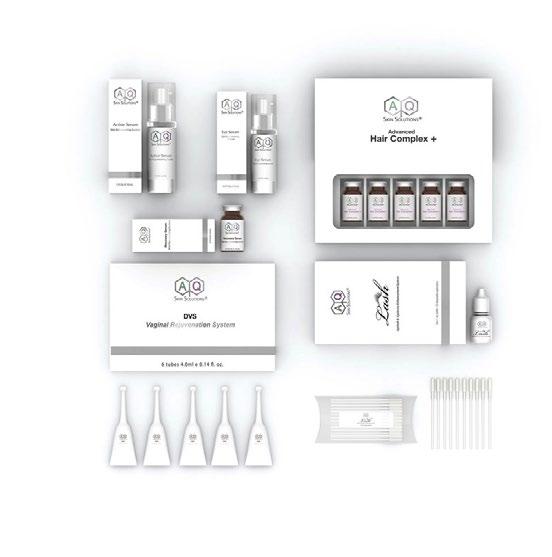
DermaFocus, distributor of Purasomes – a range of exosome and growth factor-based products from Italian manufacturer Dermoaroma – has released a complementary supplement and new Purasomes application protocol to promote comprehensive wellness from the inside out.
Purasomes XCell ensures optimal gut, skin, and hair health. Like the Purasomes product range, Purasomes XCell harnesses the power of AMPLEX Plus technology, which contains 20 billion exosomes and 20 growth factors alongside organic spirulina, Moldavian dragon head, astragalus and blue spirulina-derived vitamin B12.
Purasomes XCell is administered sublingually (under the tongue), bypassing the digestive system for faster absorption and higher nutrient bioavailability. The brand has also launched the Exosomal Liquid Laser protocol to deliver profound skin rejuvenation outcomes comparable to laser resurfacing but with minimal recovery time and without the associated risks.
The protocol includes:
• Pre-peel homecare morning: GF-20 Boost (intensive regenerative serum with 20 growth factors and peptides) and sun protection
• Pre-peel homecare evening: GF-20 Boost and Glycolic Acid 8% Night Serum
• In-clinic Treatment 1: 2ml Peel (choose from three options – Juvena/Radiance/ Restructa – depending on patient’s skin concerns)
• In-clinic Treatment 2: 1.5ml of chosen Peel, followed by application of 0.5ml Cell Renew (TCA 35%) and Purasomes (product chosen dependent on skin concerns) microneedled into skin
• In-clinic Treatment 3: 1.5ml of chosen Peel, followed by application of 1ml Cell Renew (TCA 35%) and Purasomes (product chosen dependent on skin concerns) microneedled into skin
• Post-peel homecare morning: GF-20 Boost and sun protection
• Post-peel homecare evening: GF-20 Boost and Glycolic Acid 8% Night Serum.

Medik8 has added Liquid Peptides Advanced MP to its range. The product utilises dual miniprotein biotechnology to reduce the appearance of wrinkles. The serum combines pharmaceutical-grade precision with peptide science, clinically proven to diminish the appearance of expression lines in 10 minutes and deep-set wrinkles in eight weeks.
The expression line miniproteins help to relax and smooth dynamic expression lines for visibly reduced wrinkle depth. The growth factor miniprotein visibly improves the appearance of skin structure by helping to support collagen, elastin and hyaluronic acid levels, for smoother, firmerlooking skin.

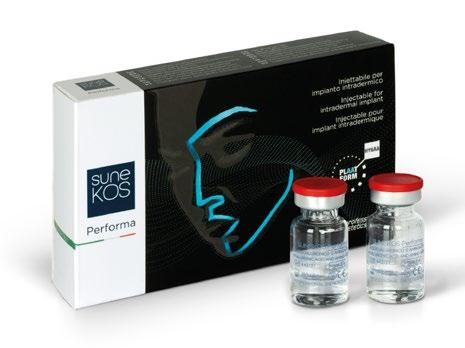
Leading aesthetic distributor AestheticSource will be distributing the SuneKOS® range. The range will launch with four amino acid-based injectables: SuneKOS® Performa; SuneKOS® 1200; SuneKOS® Body; and SuneKOS® Cell.
Designed to rebuild rather than destroy tissue, SuneKOS® Cell activates the body’s own stimulus of collagen and elastin to repair the damage which causes cellulite, as opposed to simply dissolving fat around the affected area. A combination of hyaluronic acid, amino acids and an alkaline solution, the cutting-edge formula improves the structure of the Extra Cellular Matrix (ECM), adjusting microcirculation and reducing fibrosis.
Award-winning collagen brand Absolute Collagen is launching its first powdered supplement, Crystal Clarity™ Collagen Powder – the first UK collagen powder to have clinically proven results.
The product, which has been in development for over a year, harnesses innovative technology. As a result, the new formula is the best-mixing collagen powder on the market, leaving no clumps or residue in any liquid with an absolutely undetectable taste.
Staying true to Absolute Collagen’s original liquid supplement, each pre-measured powder sachet contains the optimum daily dose of marine collagen (8000mg) and vitamin C, which has been clinically proven in the most robust clinical study of a collagen supplement, with 100% of participants experiencing improvements in their skin after 12 weeks.

The Crystal Clarity™ Collagen Powder expands Absolute Collagen’s supplement range, joining the Liquid Collagen Supplement, designed to improve skin, hair and nail appearance.








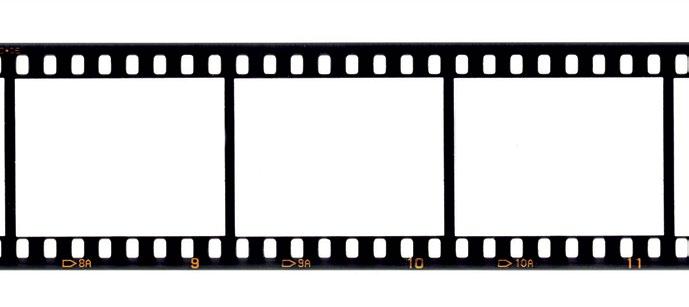














In this section • Local SEO • Marketing spend • Wigmore Presents



Struggling to get leads from your website? You’re not alone. Many aesthetic clinics invest in a beautiful website, only to find that it doesn’t generate enough patient inquiries. The problem? If your clinic isn’t showing up when potential patients search for treatments in your area, they’ll book with a competitor instead.
Local SEO ensures your clinic appears at the top of Google when people search for services. By improving your local visibility, you can turn your website into a powerful lead-generation tool. We’ll explore the main ways Local SEO can help you drive qualified leads to your site. Let’s take a look:
1. Get your Google Business Profile (GBP) in shape
Think of your Google Business Profile as your clinic’s online shop window. If it’s incomplete or outdated, potential clients might scroll right past you. Make sure your profile is fully optimised by:
• Double-checking your clinic name, address, and phone number (NAP) for accuracy
• Choosing the right business categories so Google knows exactly what you offer
• Uploading high-quality photos of your clinic and treatments — people want to see what to expect!
• Keeping your business hours and contact details updated.
2. Use local keywords to attract nearby clients
When someone searches for “Dermal Fillers Chester,” your clinic needs to be the first thing they see. Integrating these keywords is a great way to improve your visibility, but there’s a balance. They must be used naturally within your content. Overstuffing keywords can harm your rankings, so it’s important to use them in a way that feels authentic.
3. Turn happy clients into raving fans with reviews
Google loves reviews, and so do potential patients. A long list of glowing testimonials can make the difference between someone booking with you or your competitor.
Make it easy for happy clients to leave a review by:
Sending a friendly follow-up email or text with a direct link to your Google reviews page Responding to all reviews – thank positive ones and professionally address any concerns.
4. Get your clinic listed everywhere that matters
Beyond Google, make sure your clinic appears on trusted directories like Consulting Room, Yelp, and Yell. These listings give your business extra credibility and help more people discover your services.
But here’s the key: Your clinic name, address, and phone number must be identical across all platforms. Even small inconsistencies can confuse Google and hurt your rankings.
5. Make sure your website works for you
Your website should do more than just look good – it needs to convert visitors into bookings. Google prioritises sites that are:
Fast and mobile-friendly (most people will find you on their phones).
• Easy to navigate, with clear service pages and contact info
• SEO-friendly, using structured data (schema markup) to boost visibility in search results.
At Ignite SEO, we understand how important it is for your clinic to stand out and attract the right patients. That’s why we focus on results-driven Local SEO strategies that work. Whether it’s improving your search rankings, refining your website for better lead generation, or making sure you’re visible where it counts, we tailor our approach to suit your needs.
Our goal is simple: to help you get more leads and grow your business. If you’re ready to see results, we’re here to help. For more information or to book a meeting, please see our SEO for Aesthetic Clinics page.
https://www.igniteseo.co.uk/sectors/seo-foraesthetic-clinics/





Sick of spending huge amounts of money on marketing and not seeing the results? The team from PatientPerfect explain what many clinics are missing
The aesthetics sector is booming but also increasingly competitive. Attracting and keeping clients is more challenging than ever.
PatientPerfect conducted a survey of aesthetic practitioners’ marketing spend in the UK and Ireland, and identified over 80% of marketing spend is focused on acquiring new customers.
If this is you, this is costing your practice. Your first priority should be converting as many existing clients who have walked through your door into engaged, loyal advocates. You are wasting money if you are acquiring new clients without focusing on the other four engines of demand growth: retention, cross-selling, recurring revenue and referrals.
Why should you be focusing on these pillars to improve the economics of your business?

• Retention: Acquiring a new customer is up to 25 times more expensive than retaining an existing one. Losing clients is expensive
• Referrals: Engaged clients who feel valued by your business are more likely to refer friends and family. Referred clients tend to be stickier and higher spending than ‘cold’ new clients
• Cross-sell and upsell: Engaged, loyal clients spend up to three times more than unengaged clients
• Recurring revenue: Loyal clients who feel valued are easier to convert to recurring revenue, such as membership and subscriptions.
What can a clinic owner or manager do to fuel these four growth engines? We outline a few ideas that are tried and tested.
1. Increase retention and spend with a mobile rewards programme
Consumers today are accustomed to rewards programmes in every aspect of their life. Behaviour science shows the promise of a reward drives more regular visits and increased spend. Many aesthetics practices know this and have a loyalty programme in place, but clients are often unaware of it or find it difficult to track.
This is where mobile rewards come in. Smartphones are almost always within reach, making them the best channel for delivering rewards and engaging with consumers. 60% of global e-commerce happens on a mobile phone more than on a desktop. For the average UK consumer, 80-90% of time spent online is on a mobile phone.
A mobile rewards app enables your clients to be kept up to date with push notifications on their loyalty status, on recent, personalised promotions or new services and enables a direct line of communication between clients and the clinic team. Mobile-only rewards can help you create a sense of exclusivity and urgency so clients take up offers and book in.
2. Gain WARM clients through digitised referrals
Word of mouth is one of the most powerful levers for acquiring loyal and high-spending clients in the aesthetics and wellness industry. Clients want to visit practitioners who are trusted. Again, many clinics have referral programmes in place, but they are clunky and not fulfilling their potential. A tool that enables you to design incentives for your clients and the friends and family they invite that can be sent in one click is shown to significantly increase the volume of new, referred clients.
3. Offer easy-to-manage memberships, but sell them properly
Memberships are a hot topic in the sector right now. The clinics that get them right increase the average annual spend of their
clients and lock in reliable monthly revenue. Imagine converting a client who comes in twice a year for an injectable procedure to one who comes in 6 times a year for regenerative treatments in addition.
Many clinics launch memberships but don’t see them successful. There are two reasons for this. First of all, they are not selling them proactively in clinic. Clinic staff need to talk about them and their benefits to clients. Secondly, there is not an easy-to-access portal for clients to see, manage, or even pause or cancel their memberships. This is something customers get in any other subscription service in life, but aesthetics clinics fail to deliver.
4. Engage them with mobile-first communications
Email marketing does not work anymore, you know that. Most clients don’t even open it, let alone read it. To get into your clients’ headspace, you need to be engaging them on their mobile phone, be it SMS, WhatsApp, push notification or other mobile messaging services.
Having seen these huge gaps in the marketing toolkits of aesthetics clinics, we built PatientPerfect to offer these features and more in a custom-branded app for your clinic. It is a clinic growth powerhouse proven to improve retention and increase client spend and referrals whilst saving time and admin for clinic teams.
Your clients rightfully demand the best possible experience, and for a modern clinic, this means being mobile-first and rewarding their loyalty. PatientPerfect helps you achieve this with set-up in a matter of days, a very high level of customer service and immediate commercial impact.
Visit www.patient-perfect.com or contact us directly at hello@patient-perfect.com.


If you haven’t booked your tickets yet, here’s five reasons why you should


With full delegate passes running low, do not hesitate to book your tickets to this renowned educational event, complete with a masterclass on regenerative medicine and longevity and the wildest wild west networking event this side of the Atlantic! See below for featured highlights.
Prof Sebastian Cotofana, the world’s leading anatomist, will be linking in directly from Argentina on Saturday afternoon alongside a distinguished panel of colleagues from the RCP: Dr David Eccleston, Dr Simon Ravichandran and Dr Raj Thethi on the Wolfson Theatre stage. This cutting-edge, state-of-the-art virtual session will showcase 3D modelling of a cadaver dissection live from Buenos Aires. As an educator,
Professor Cotofana is dedicated to teaching both basic and clinically applied anatomy to healthcare professionals globally. His research focuses on applied clinical and functional anatomy of the face, particularly concerning surgical and non-surgical treatments. He has authored over 250 peer-reviewed articles, book chapters, and online communications, contributing significantly to the scientific literature in aesthetic medicine.
Do not miss your only opportunity this year to see Dr Zein Obagi live in the UK. Along
with Rick Woodin, ZO’s Chief Scientist, Dr Lauren Jamieson, Dr Anna Hemming, and Sara Cheeney, Saturday’s ZO Symposium in the Seligman Theatre will bring to life the importance of skin health restoration in aesthetics and how to treat common skin problems.
Alice Hart-Davis of the Tweakments Guide will also be asking the key questions to Dr Obagi, about his techniques, products and experiences.
We are lucky to have a formidable press event, where leading aesthetic journalists will be hosting an interactive session for you to learn about how to work with the press and gain media attention, building key relationships along the way. Come and learn about what topics and events are interesting and relevant to the industry press, why some items are considered newsworthy and, finally, the importance of expert commentary, how it works and how to offer it. Please join journalists and writers Alice Hart-Davis, Luca Ferrari, Victoria Woodhall, Francesca OgiermannWhite and Olivia Falcon to discuss these topics and more on Friday afternoon in the Seligman Theatre.
Emerging technologies in cell science Dr Pamela Mok and Kurt Wee will be coming from Singapore to discuss their groundbreaking research and commercialisation efforts in regenerative
medicine, with a focus on stem cell-derived secretome technology.
With a vision to harness the body’s intrinsic repair mechanisms to develop next-generation therapeutics for tissue regeneration, anti-ageing applications, and chronic wound healing, this talk on Friday afternoon will be one for the future.
Alongside our exhibitors, Wigmore Medical will be taking control of the Lasdun Hall to show you all the ways that we can help you grow your business and your knowledge and development in the aesthetics industry. Our exclusive brands, with exclusive offers, will be showcased alongside a number of new product launches—complete with balloons! So do not forget to come and pay us a visit —as we all know, it takes a village to raise a child (in this case, your business).
Yee Haw! As we are putting the final touches to our networking event, we hope you are putting the final touches to your outfits! There will be prizes for the bestdressed male, female and team—so bring out those cowboy boots, flaunt that fringing and glam up in gingham; we cannot wait to see you there, mint julep in hand.
Tickets are running low. Head to wigmorepresents.com to book your place.
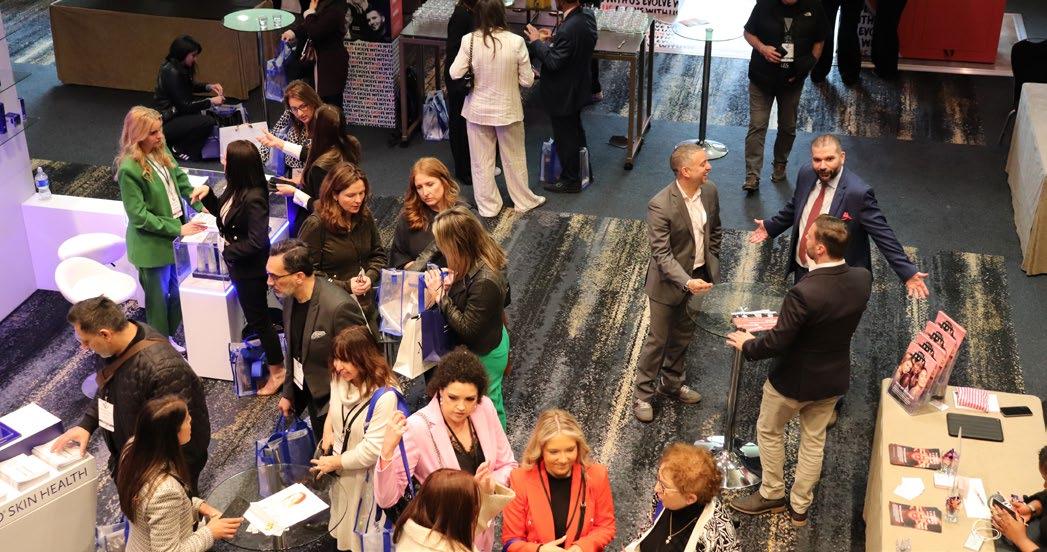



Saturday 29th March 2025, at the International Convention Centre Wales, Newport
The Welsh Aesthetics Symposium is open to all medical professionals - from Wales, England, Scotland, and Ireland - and they invite NMC, GMC, GDC, HCPC, and GPhC registered professionals to join them for a day packed with cutting-edge education, networking, and industry insights.
For more information, please visit www.welshaestheticssymposium.co.uk
Thursday 26th June - Friday 27th June 2025, at the Business Design Centre, London FACE’s comprehensive programme is delivered by over 150 national and international speakers ensuring practitioners receive high-level scientific content from true experts around the core services driving the aesthetic medicine market. For more information, please visit https://www.faceconference.com/
Thursday 25th September - Friday 26th September 2025, at the Excel, London
The Clinical Cosmetic Regenerative (CCR) Congress is dedicated to delivering evidencebased education and innovative products to shape the future of medical aesthetics. From injectables and devices to skincare and business, this is the only event where you can experience the full expanse of the medical aesthetics specialty
For more information, please visit https://www.ccrlondon.com/



Event Highlights:
Patient safety, regulatory standards, and managing complications.


Advancements in regenerative medicine and menopause-related skin changes. Importance of early skin cancer detection.
Business innovations to elevate your clinic
Keynote Speakers:
Dr. MJ Rowland Warmann
Professor David Sines
*limited seats

Saturday, 29th March
At 8 AM - 5 pm ICC Wales in Newport
The inaugural Welsh Aesthetics Symposium (WAS) is set to make its debut on Saturday, 29th March, at the ICC Wales in Newport. This landmark event will bring together some of the most respected voices in aesthetic medicine, offering a CPD-accredited agenda designed to blend clinical insights with practical business guidance.
This symposium promises to empower practitioners with essential knowledge and tools to elevate patient care and drive industry standards forward. REGISTER NOW

All the training course listed below and more can be found on www.cosmetictraining.co.uk
March | Marion Gluck Training Academy
This one-day course will explore personalised approaches to addressing symptoms experienced by many ageing males, such as fatigue, decreased libido, erectile dysfunction, depression, and more. The course will cover Testosterone Replacement Therapy (TRT) and DHEA supplementation with licensed therapies and compounded options, where appropriate.
Any time | Flexible online access
Learn how to turn consultations into profitable sales with ConsultingRoom.com’s CPD-certified therapist training. Converting consultations effectively can boost your clinics revenue and save marketing expenses. Empower your therapists and aestheticians to make your clinic more profitable by creating lasting customer relationships. Don’t miss out on potential earnings; invest in your staff now.
Anytime Online | Consulting Room Academy
Want to convert more consultations into profitable sales? Teach your therapists and aestheticians how to convert more consultations into sales with our CPD-certificated therapist training. FREE for ConsultingRoom.com Members.
Various Dates Available | Cosmetic Courses
In partnership with Dermafocus, we are now offering our delegates training in Mastelli’s Polynucleotides High Purification Technology (PN HPTTM). Learn how to perform this revolutionary treatment safely to provide the best results for your patients.


by

A Non-Invasive Workout for a Naturally Youthful Face. Revolutionise your facial treatments with FaceSTIM, a standout feature of the Jovena® device. Designed to tighten, volumise, and tone both skin and muscles,

• Activation of all facial muscle and skin fibres simultaneously.
• Increased collagen and elastin for reduced wrinkles and enhanced lift.
• Immediate and long-lasting results with zero consumable costs.
Easy to sell courses
• A comfortable, 30-minute treatment suitable for all skin types.

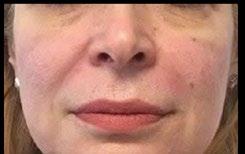
Jovena is a cutting-edge bioregenerative platform designed to transform your approach to aesthetic treatments.
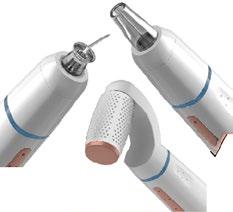
Jovena® takes on a unique approach to skin regeneration by combining two patented modalities in a single device. Not only does it feature the amazing FaceSTIM, RF DiatermoContraction® to reach deeper dermal layers and muscles, it also includes class leading Fractional Plasma® options for minimally invasive microsurgery, in the form of three highly innovative handpeices.


treatments by combining advanced RF Diatermocontraction® technology with customisable solutions to tone and tighten muscles and skin.
• Improved skin texture and elasticity through hyaluronic acid production.
• Reduction in cellulite and enhanced oxygenation of tissues.
• Increased muscle hypertrophy, local metabolism stimulation, and ATP production.
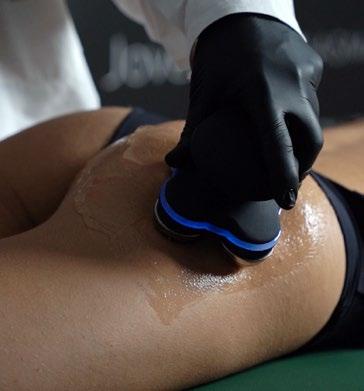
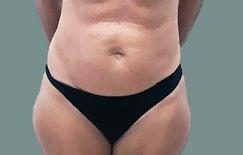
6 sessions of 30 minute treatments
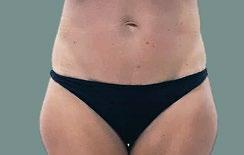


Multi-pad RF technology simulates intense exercise, delivering visible results in less time.
biQuad+™ Precision handpieces for effective treatment of uneven areas.

Customizable solutions combining Thermosculpt™ and biQuad+™ for tailored results.
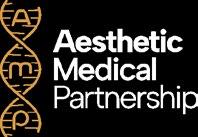
Contact